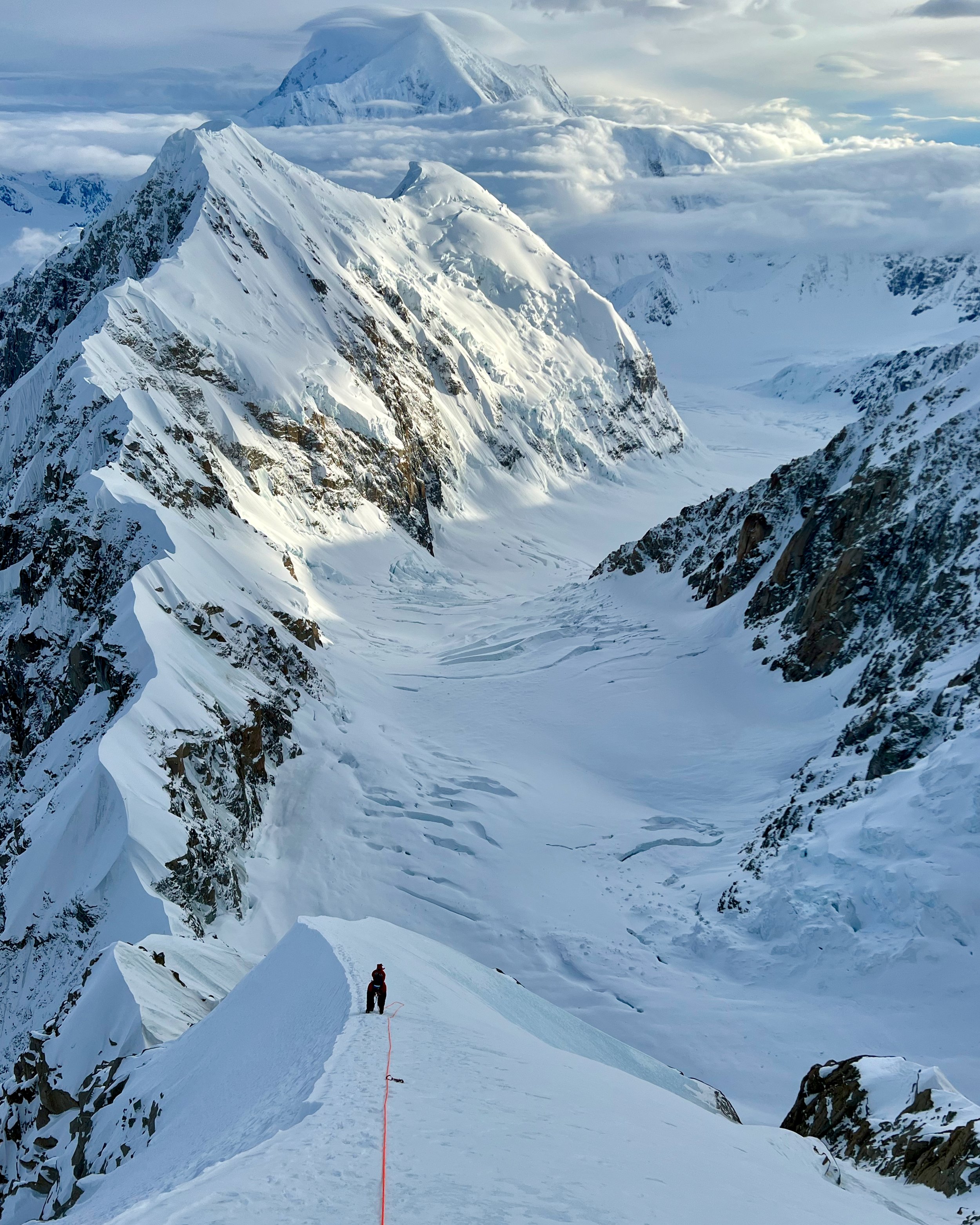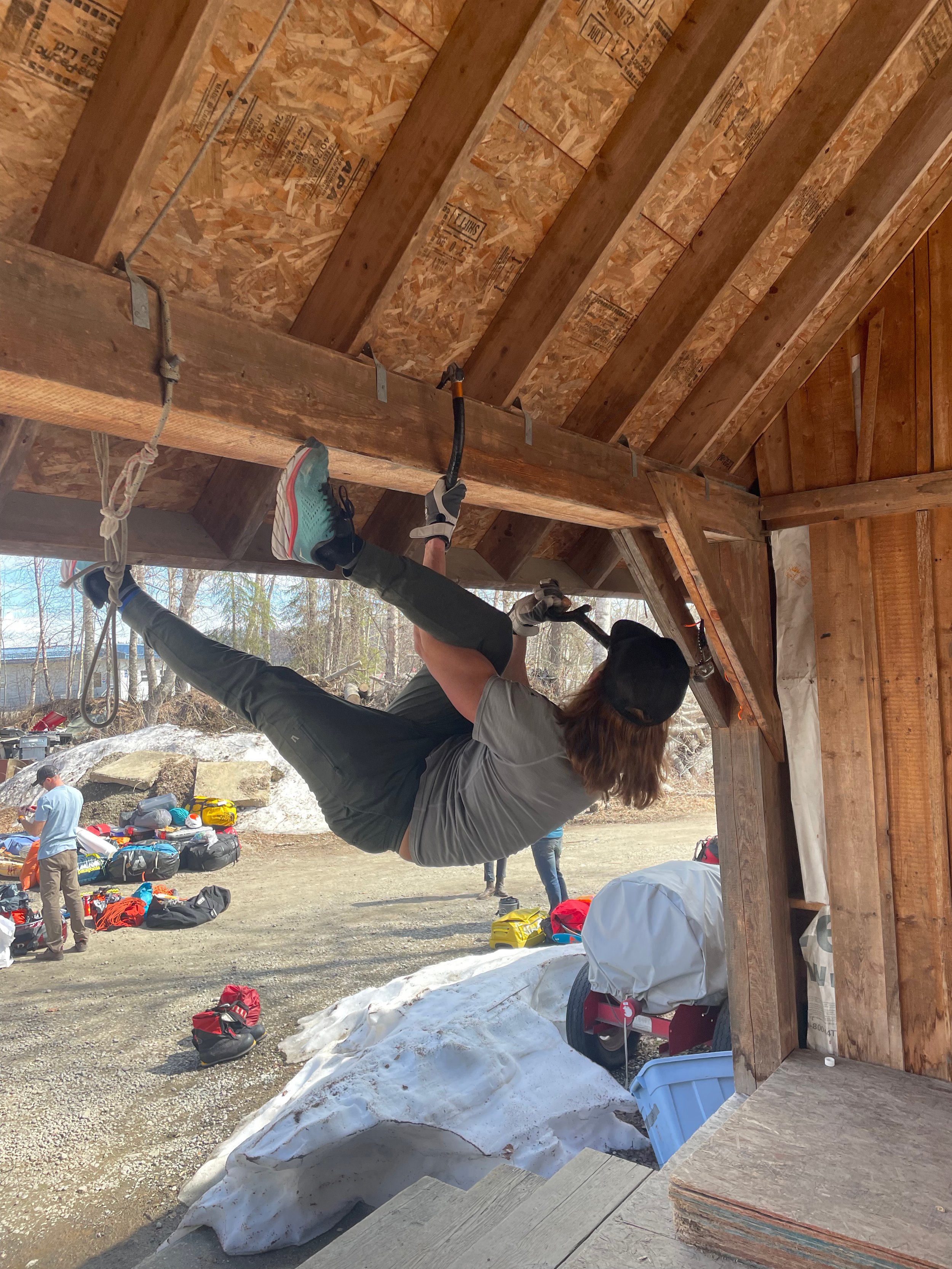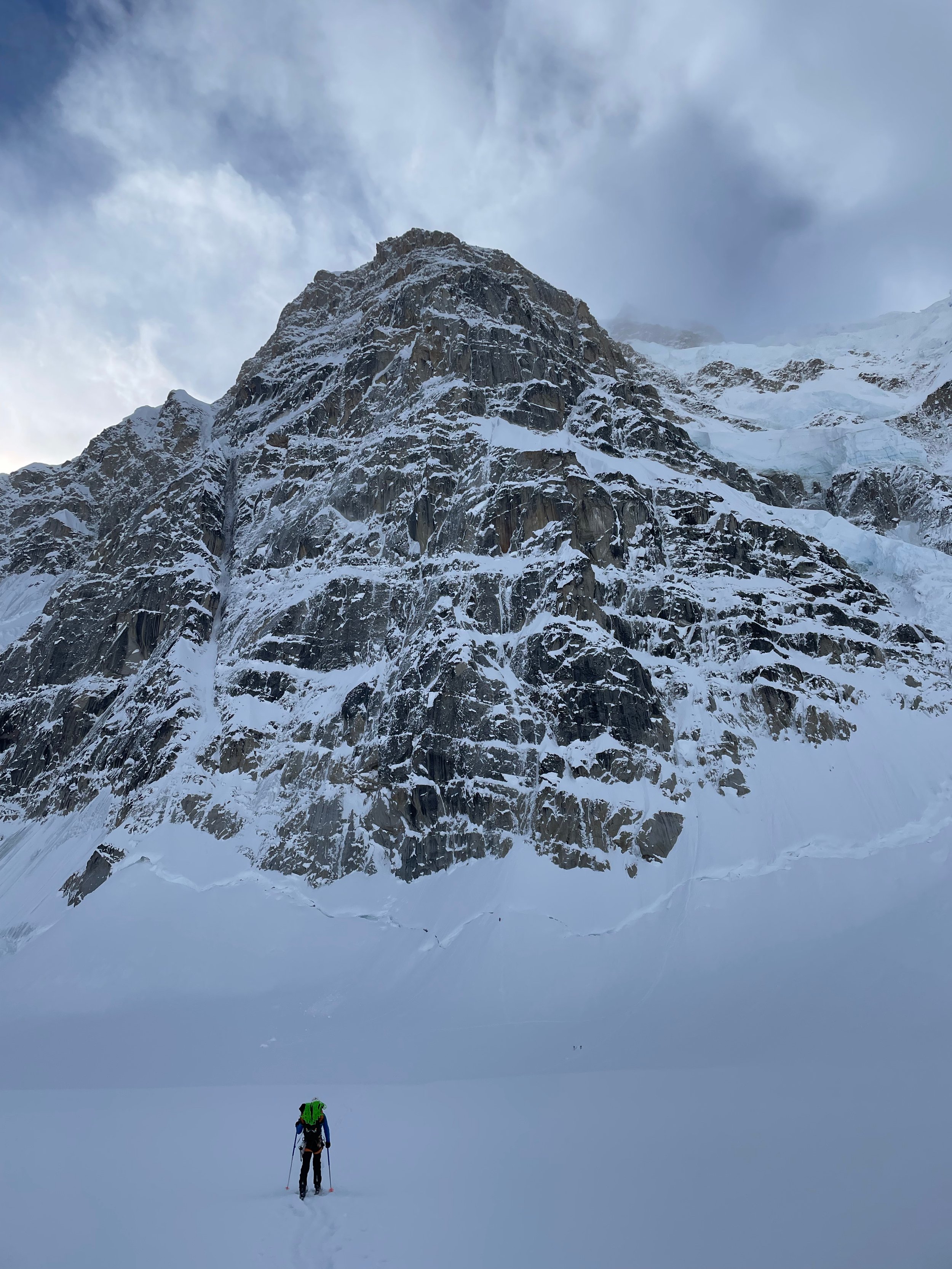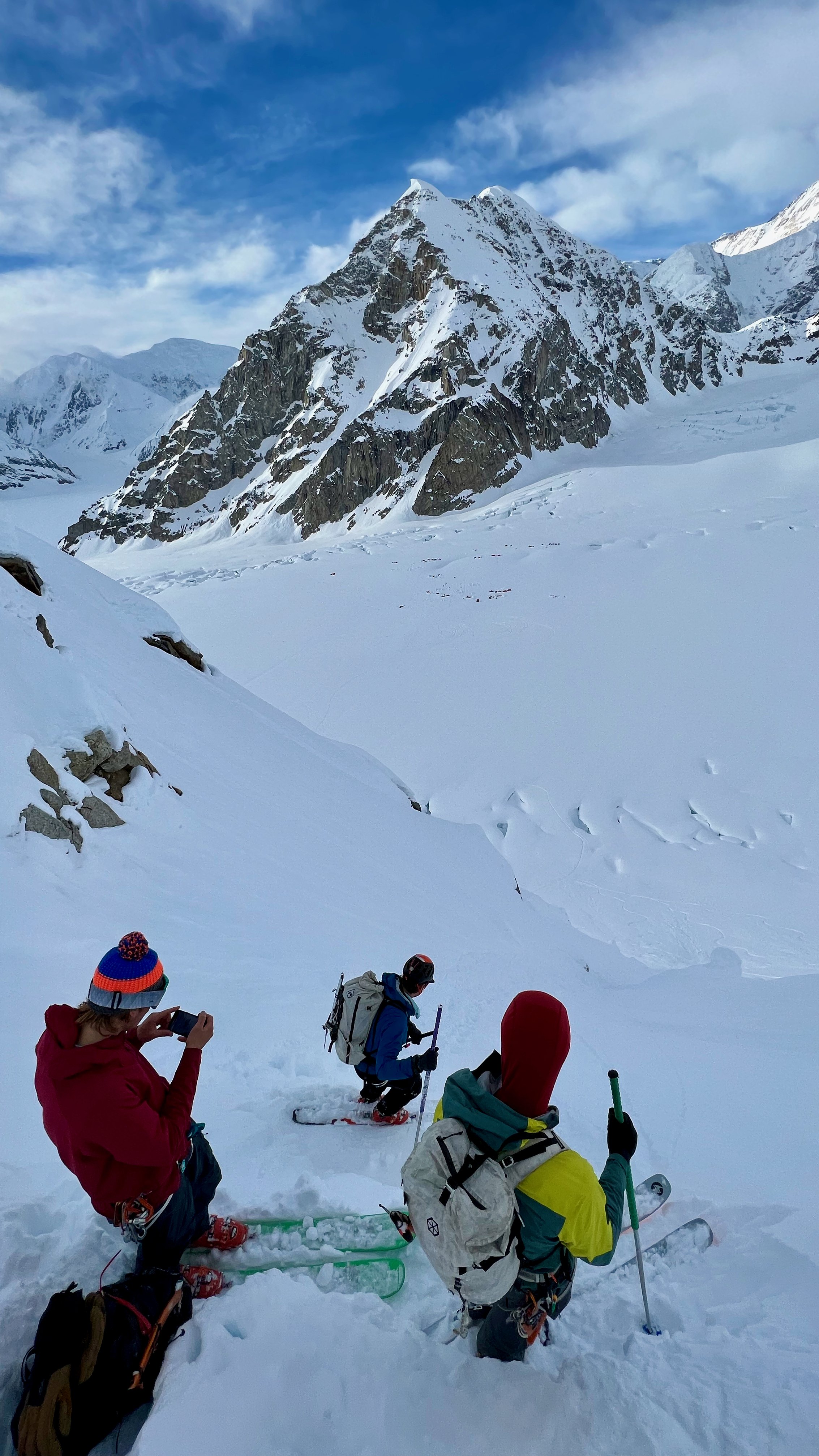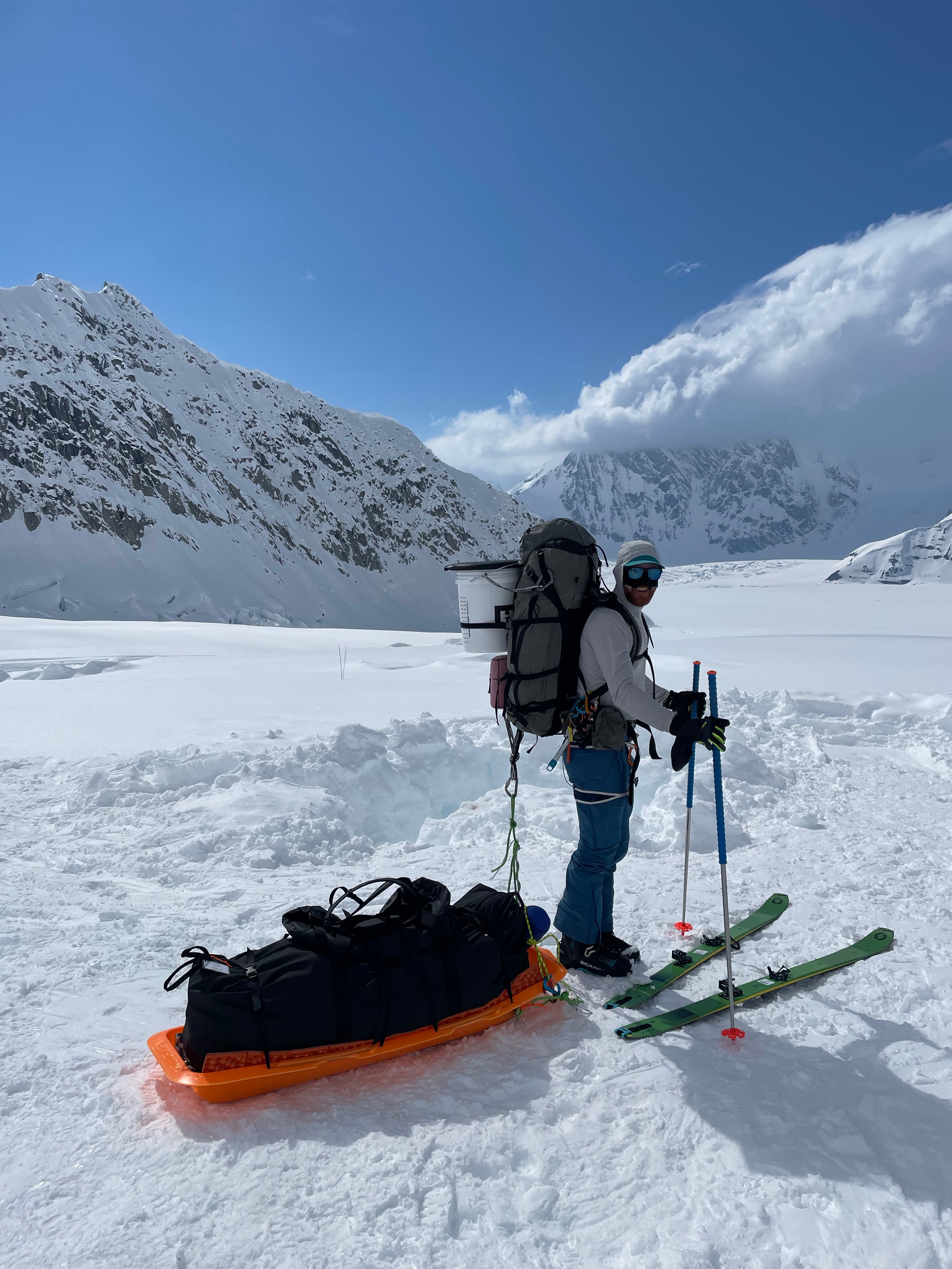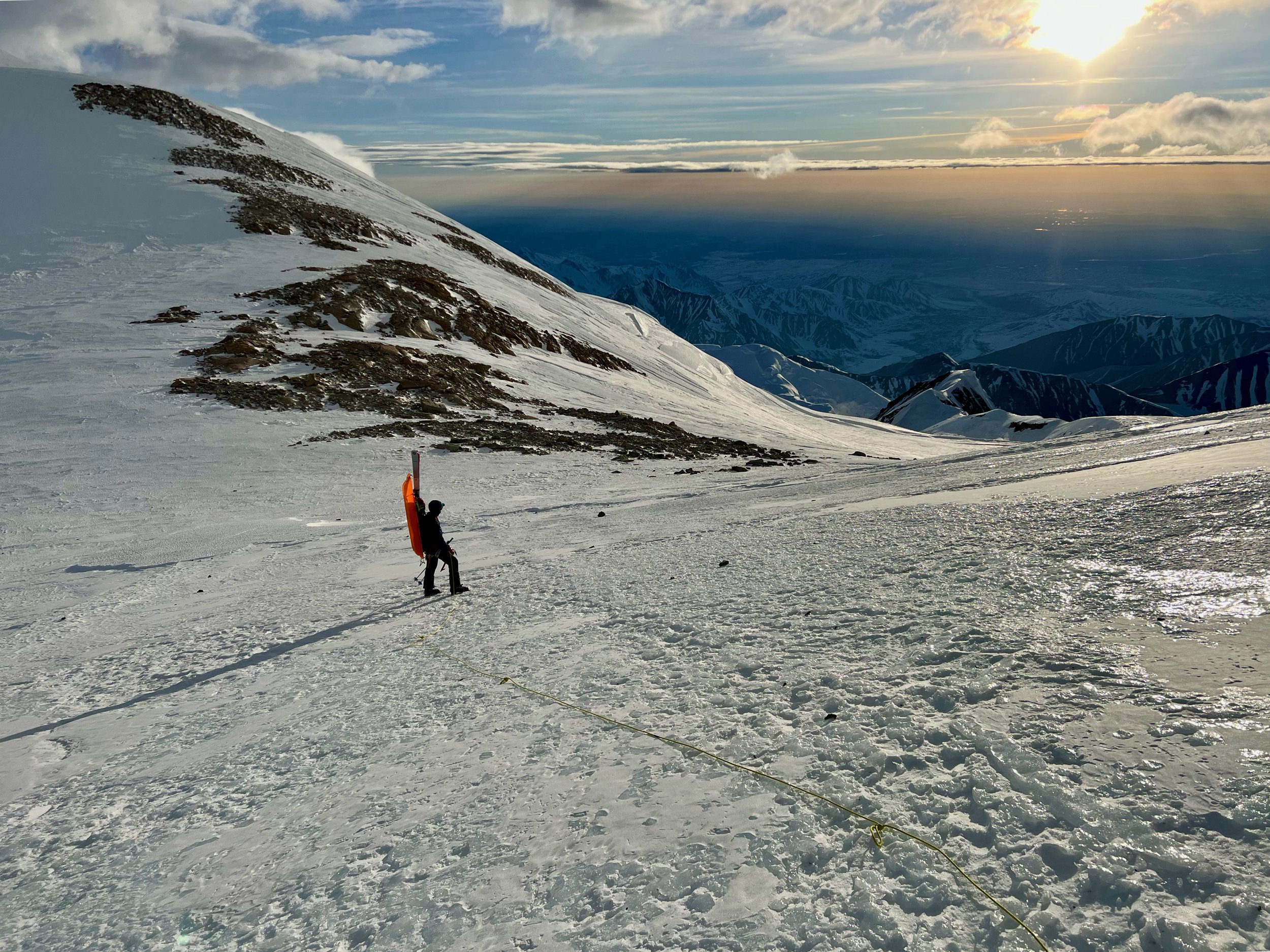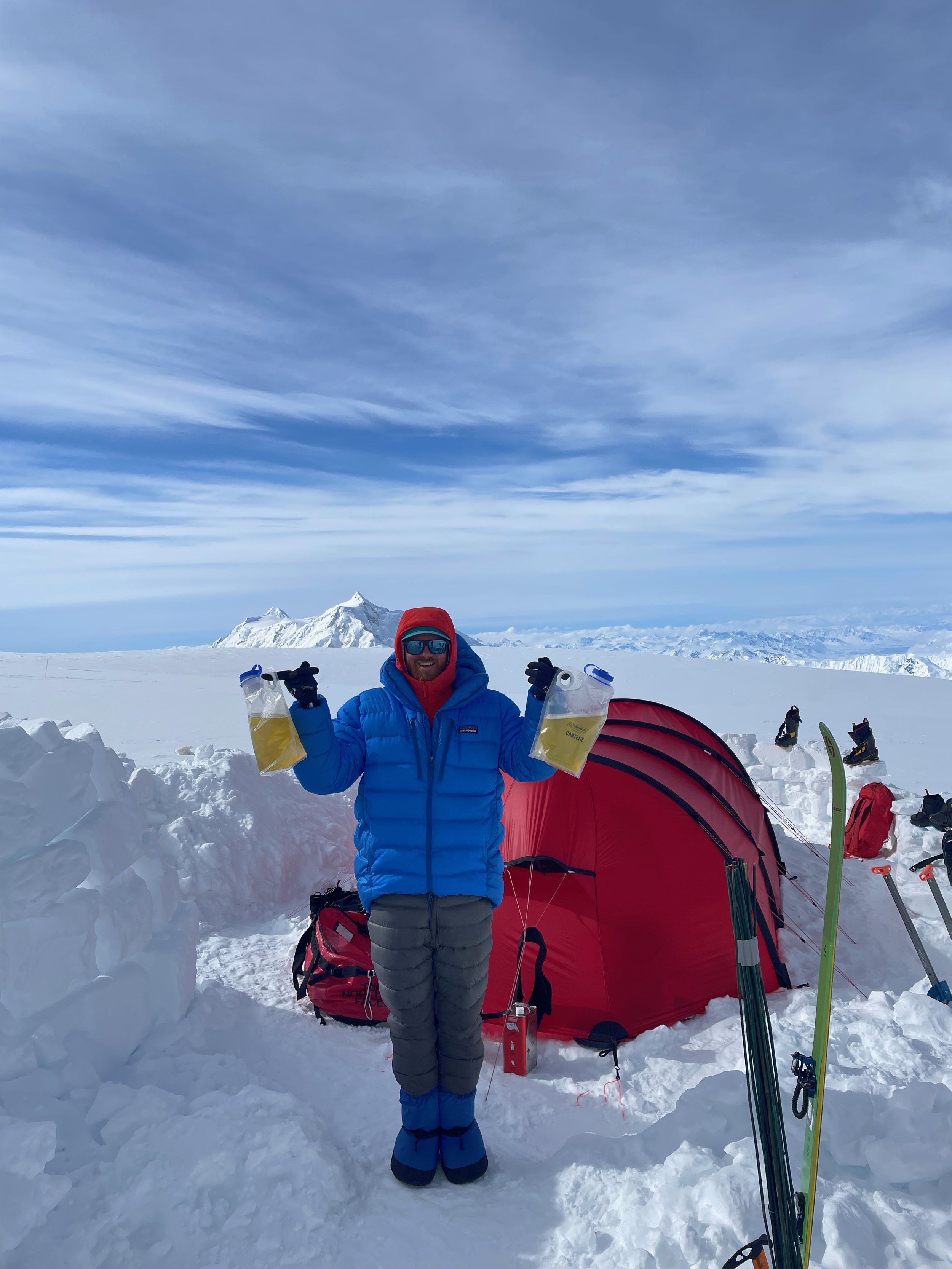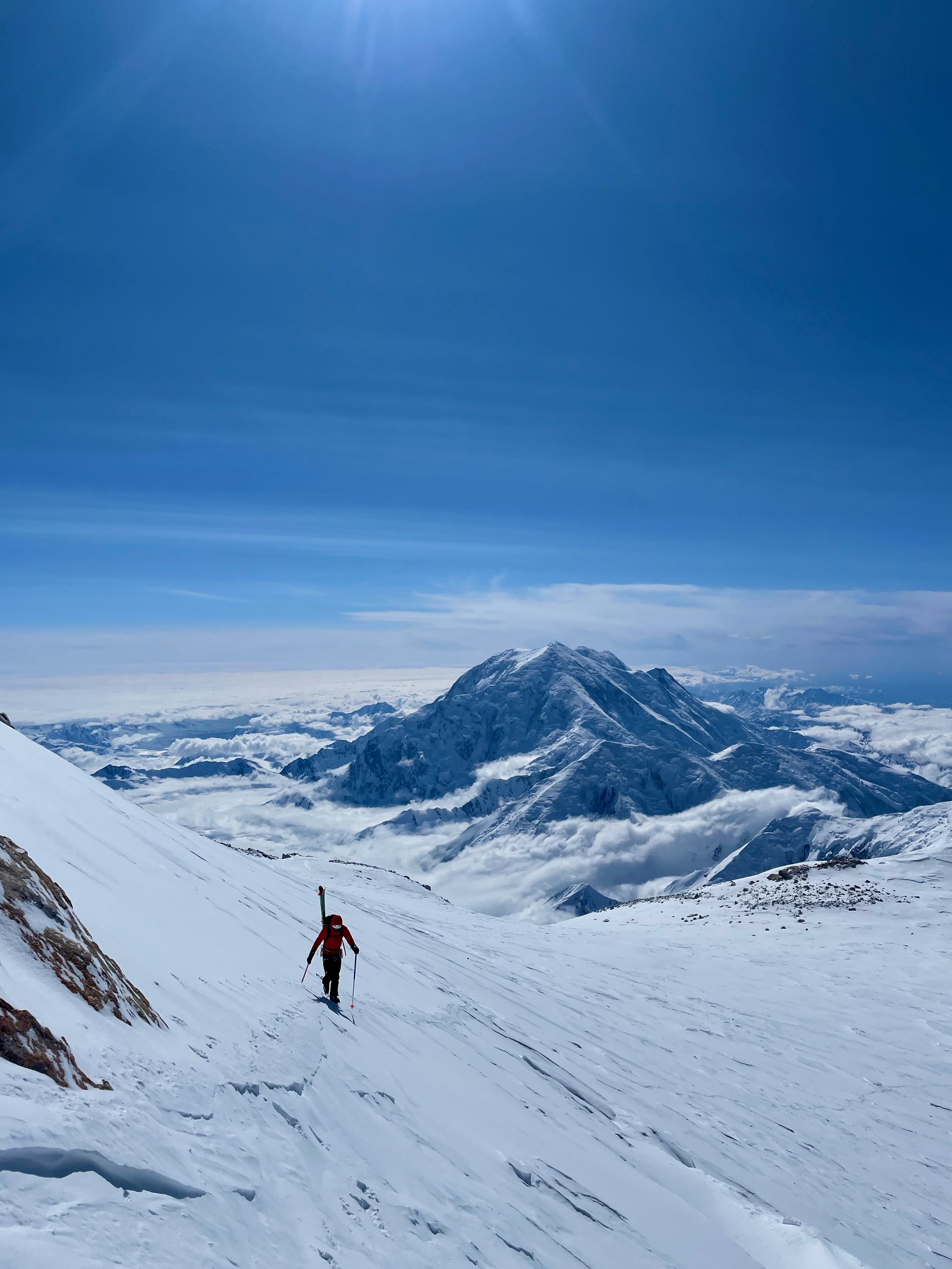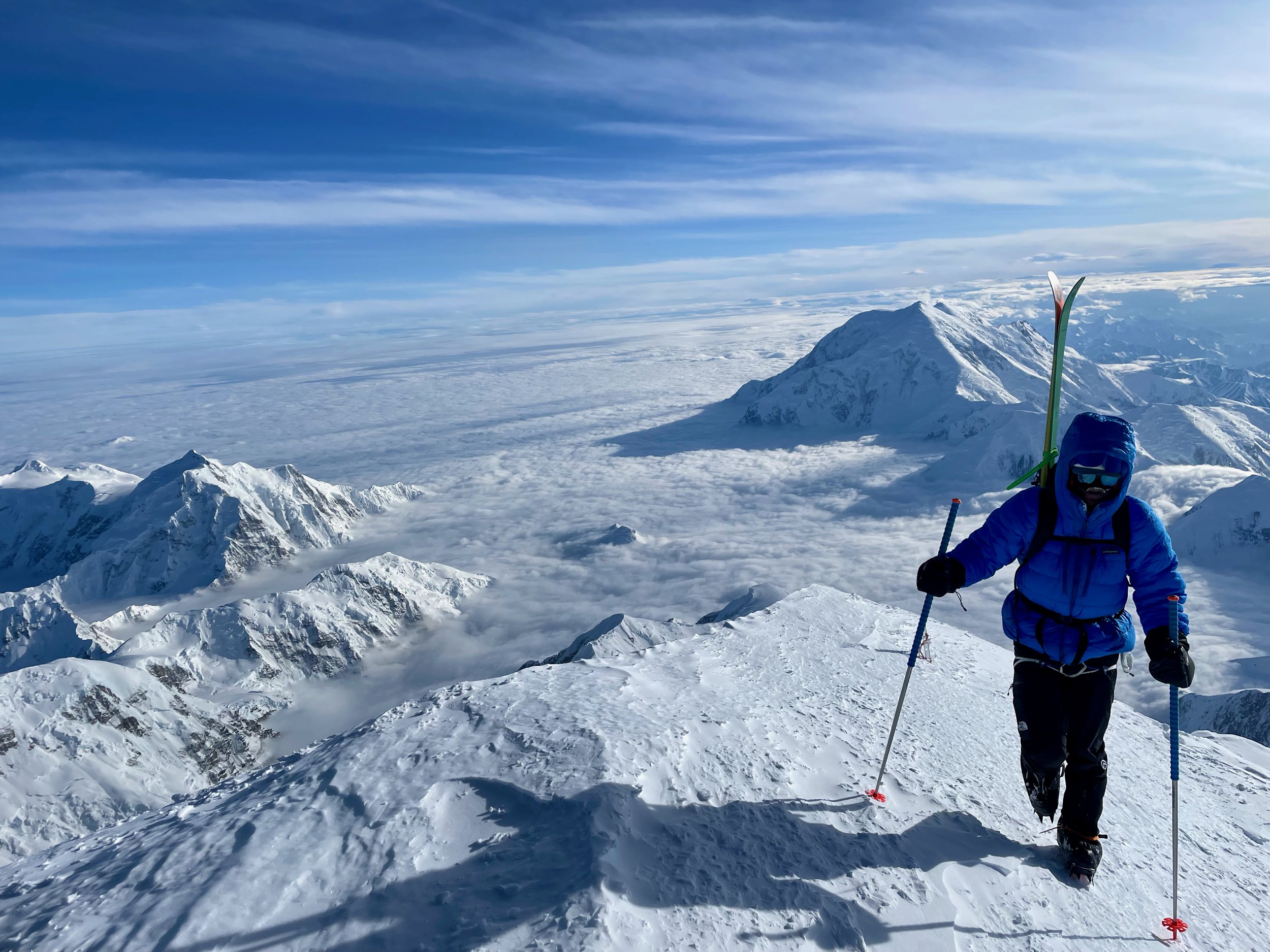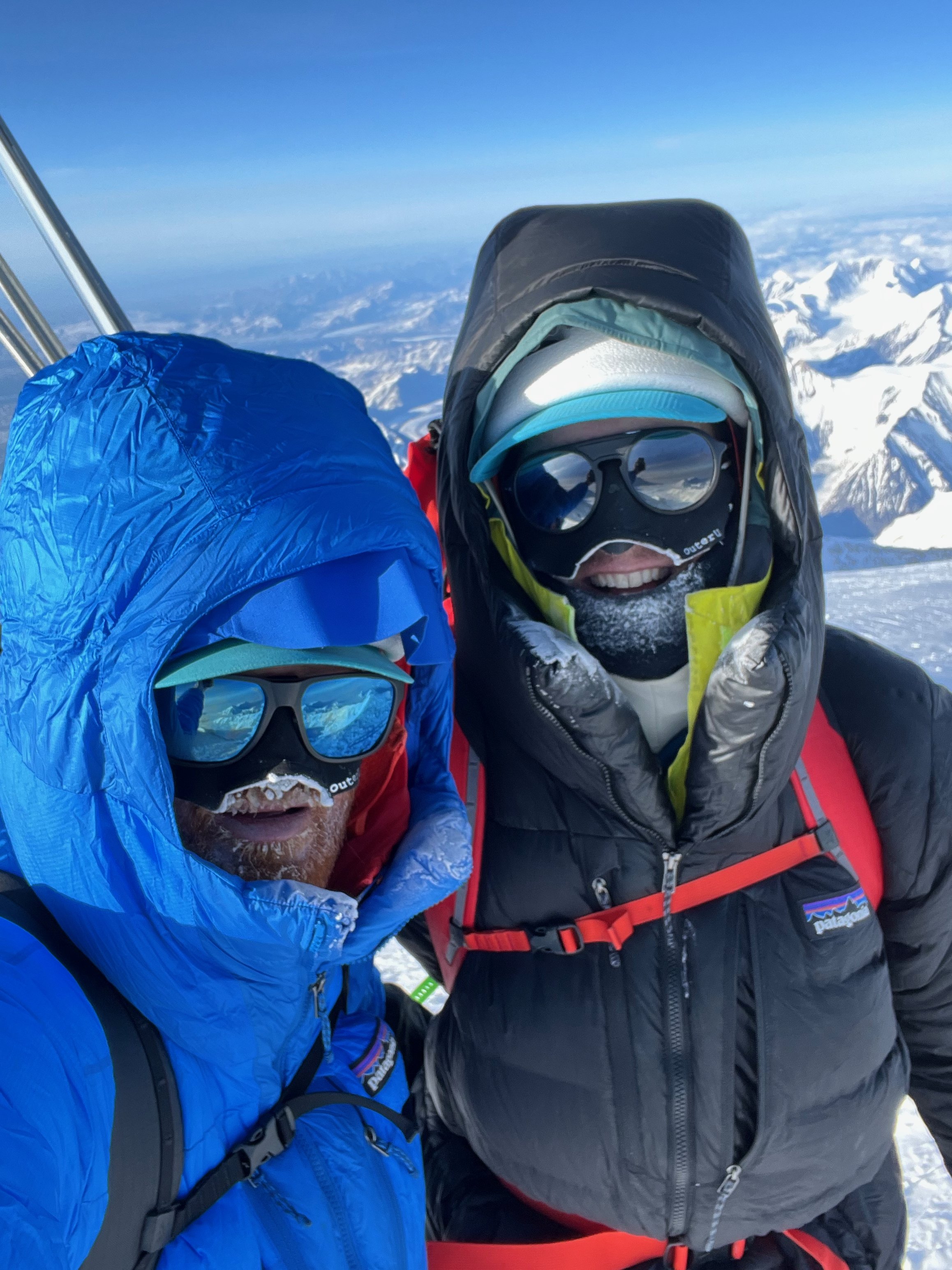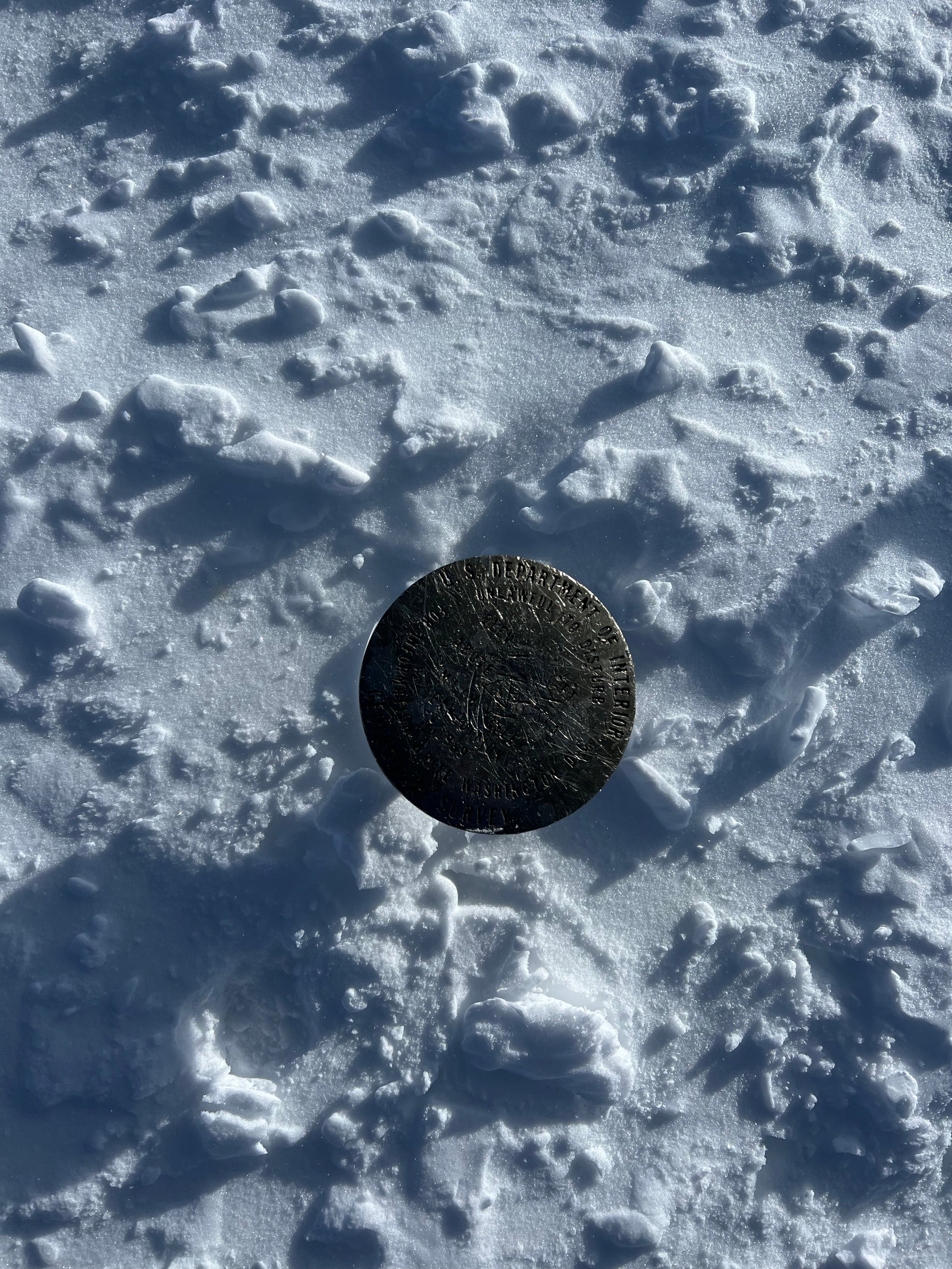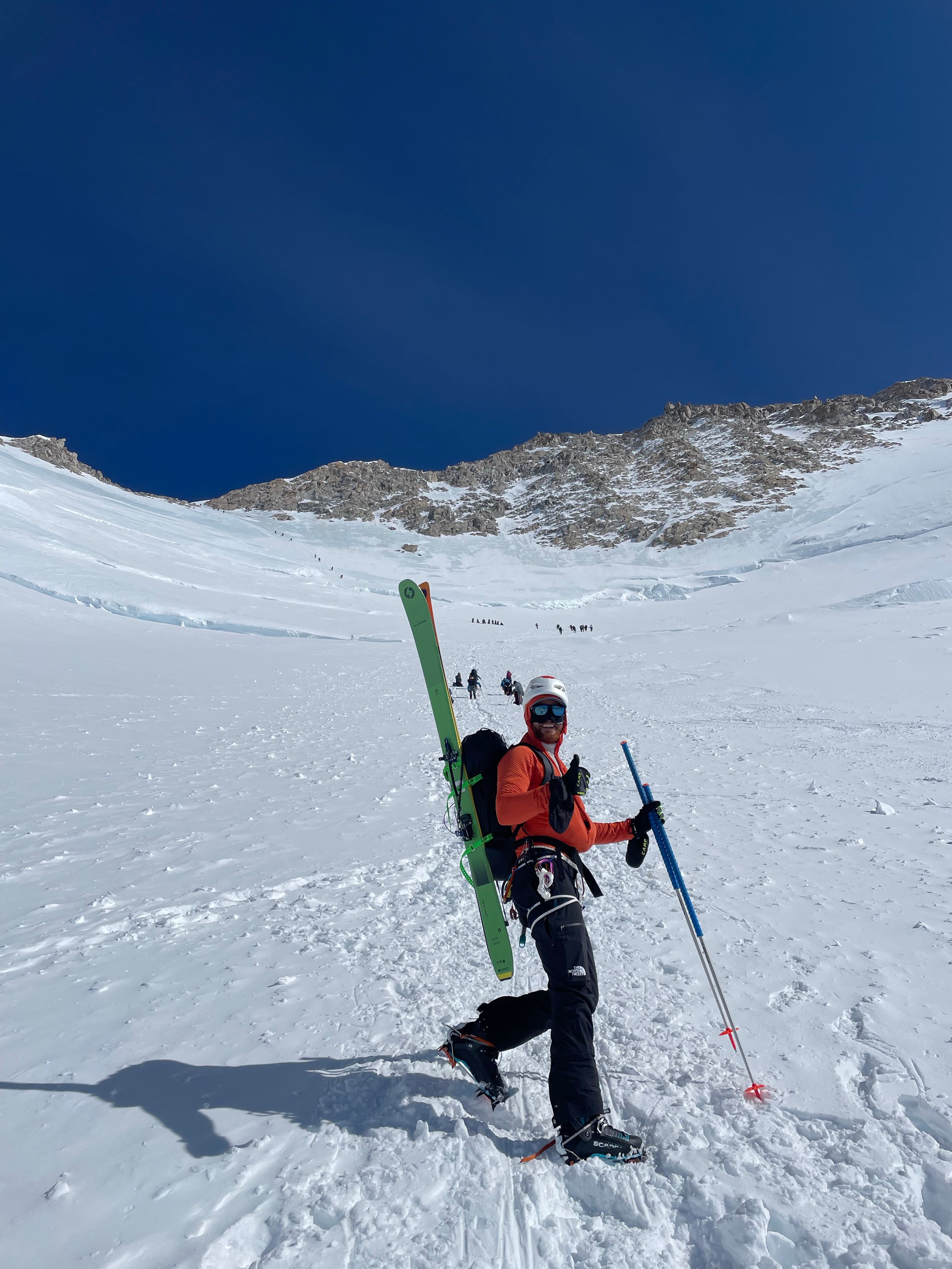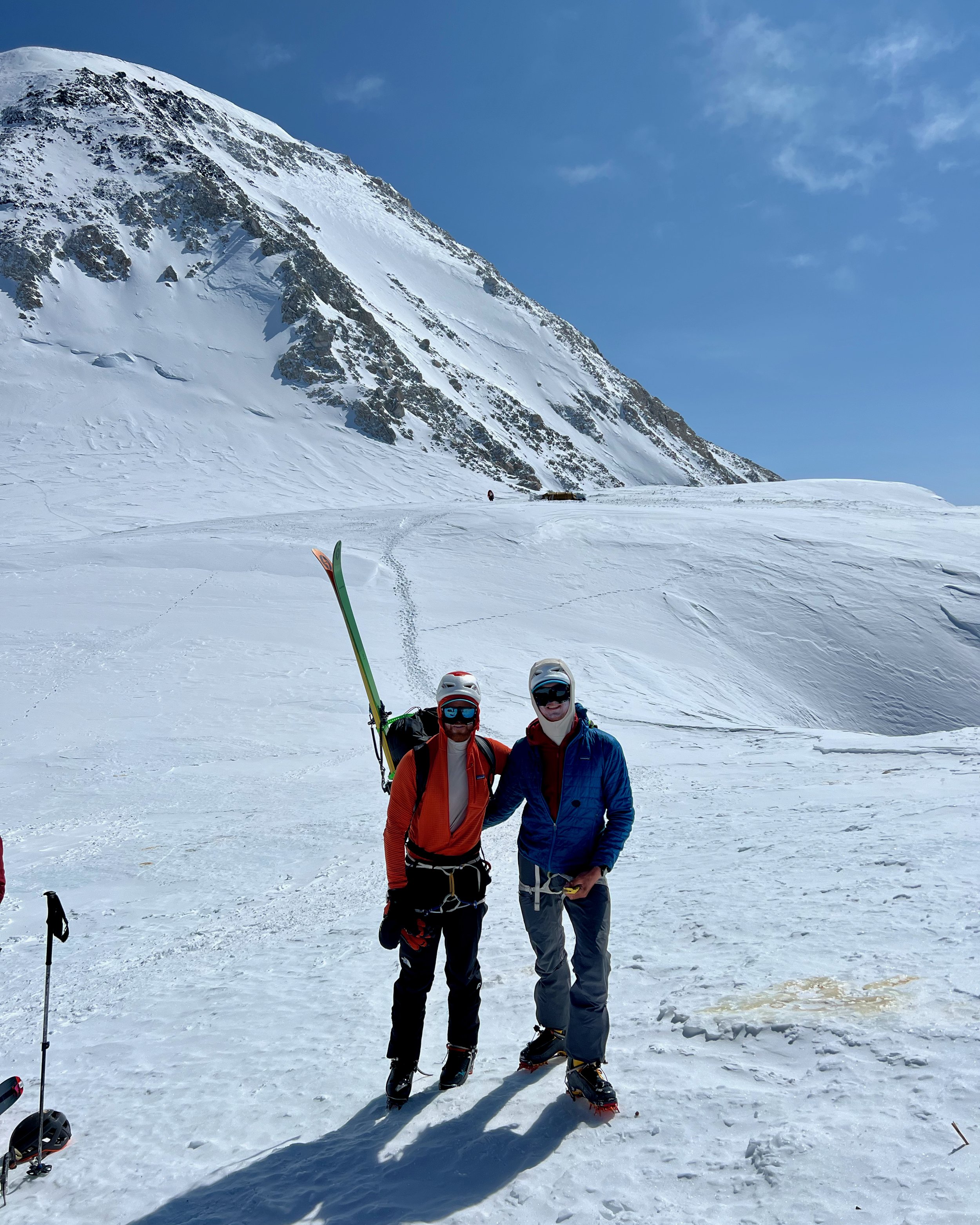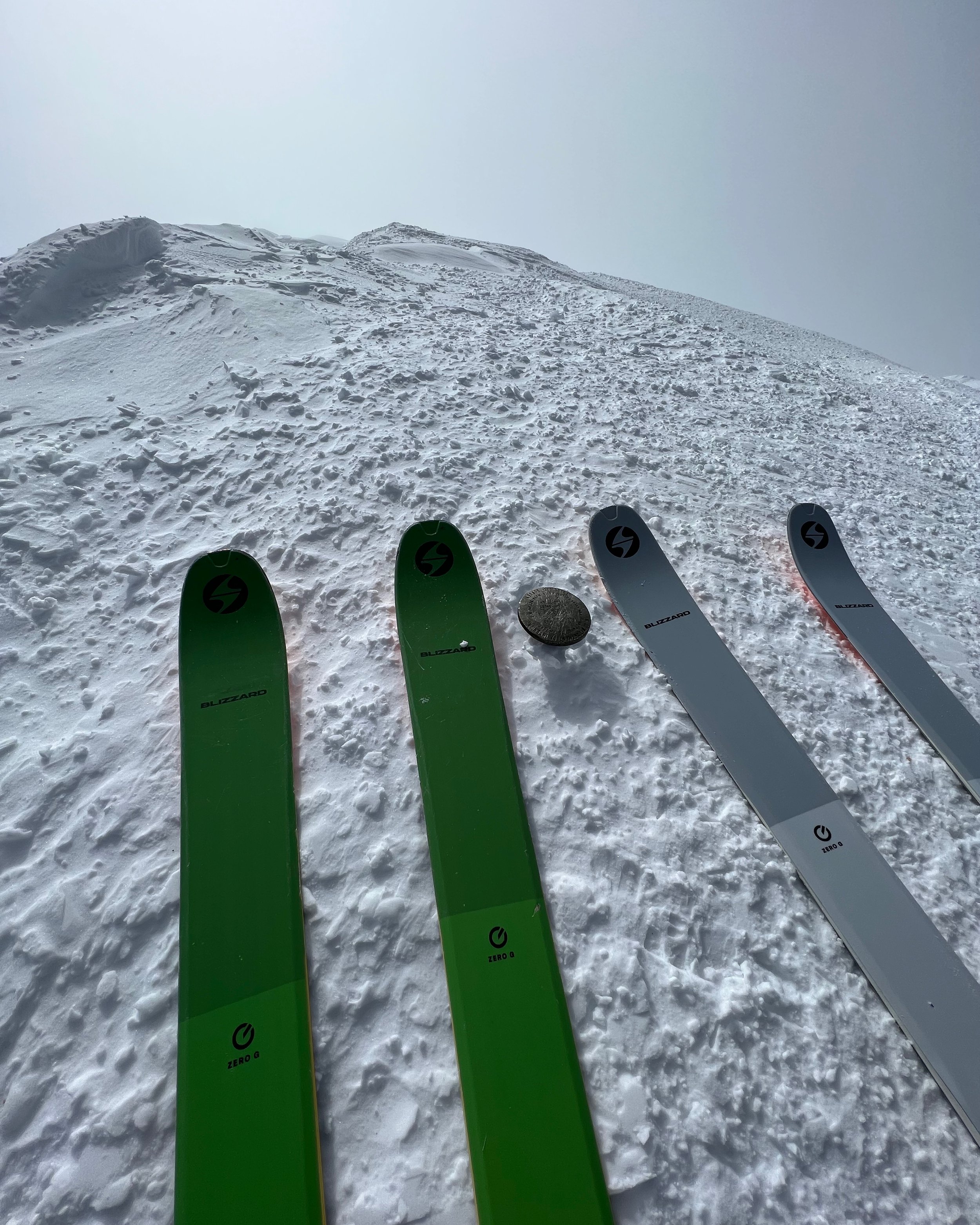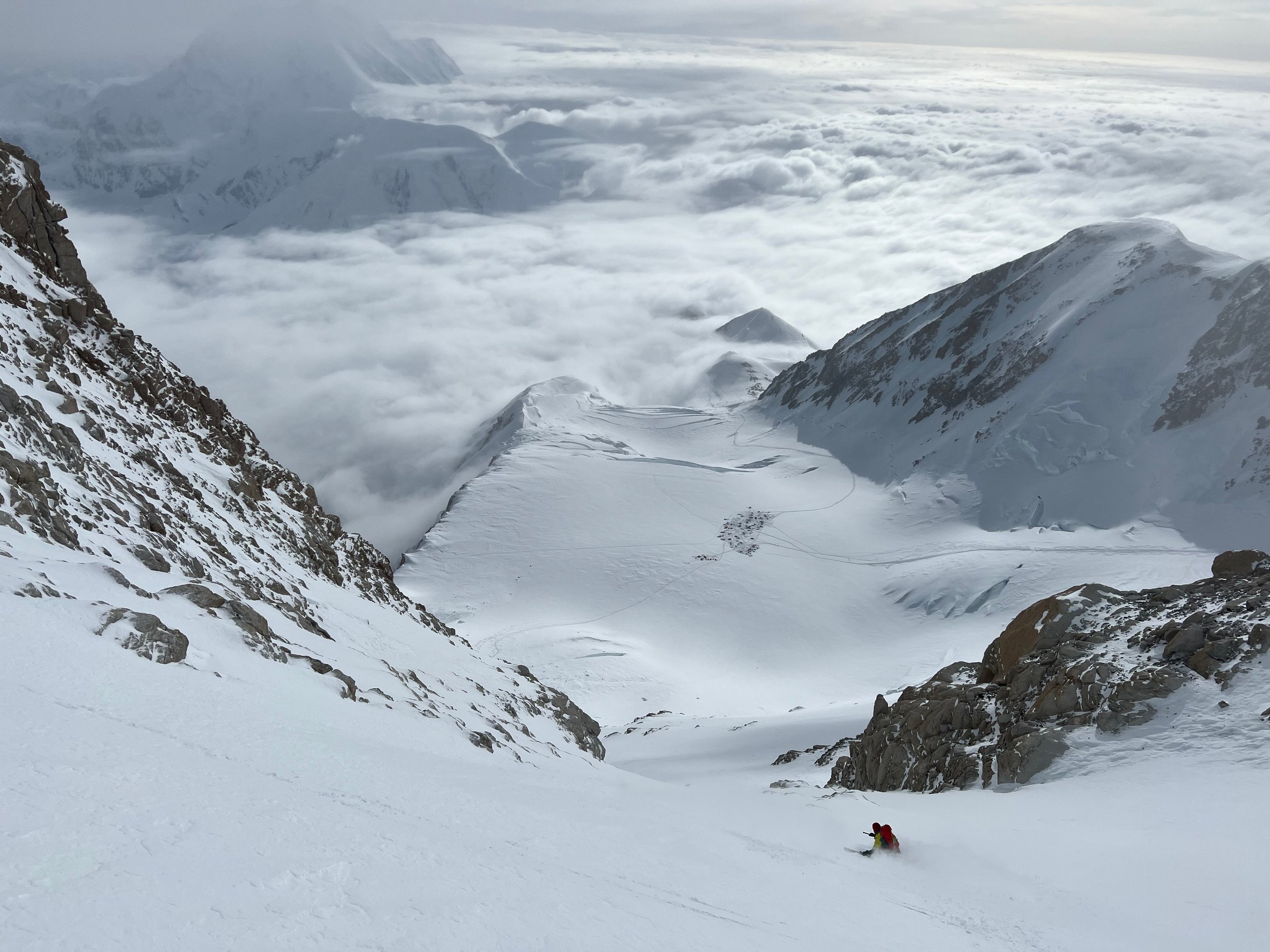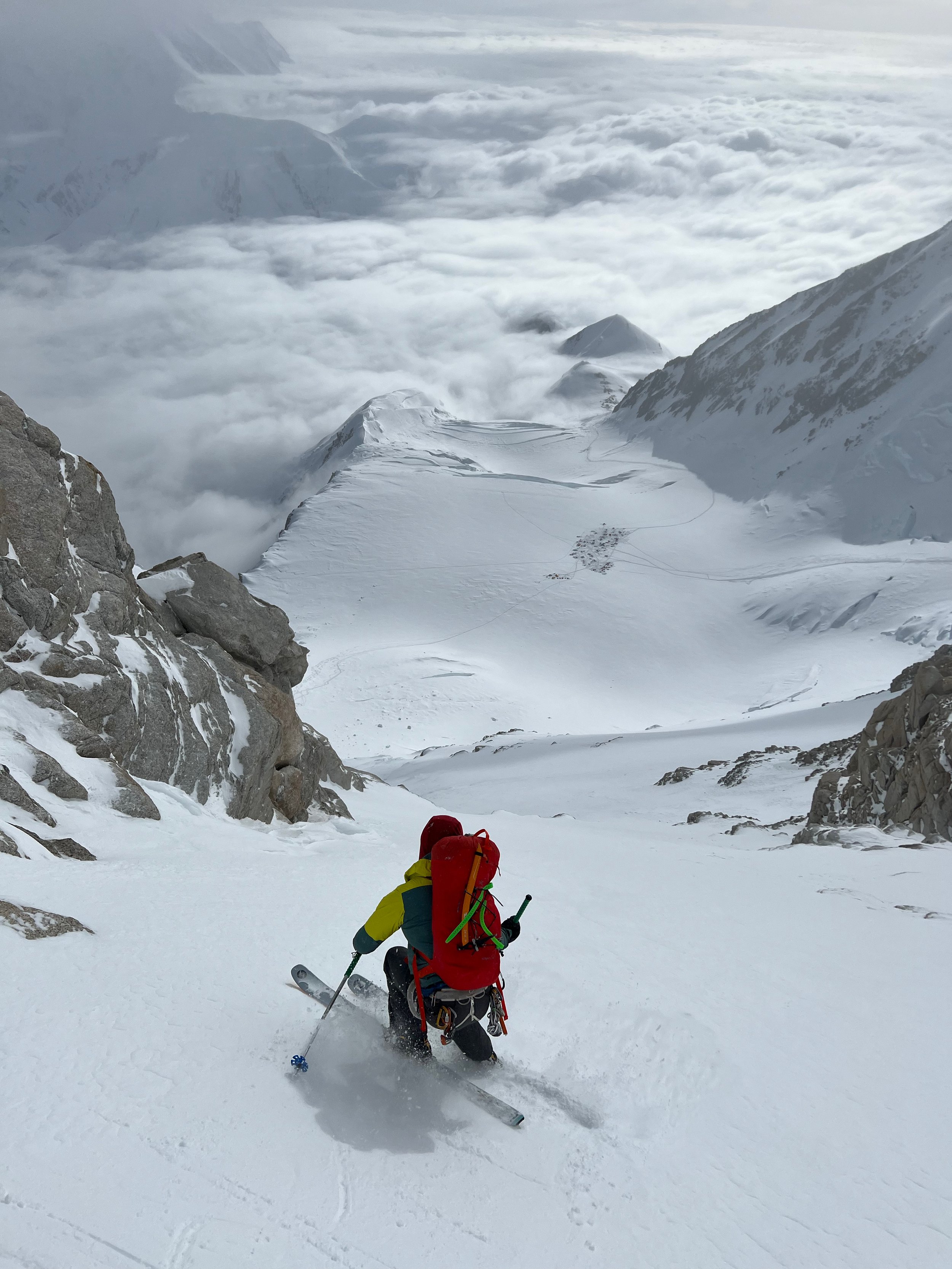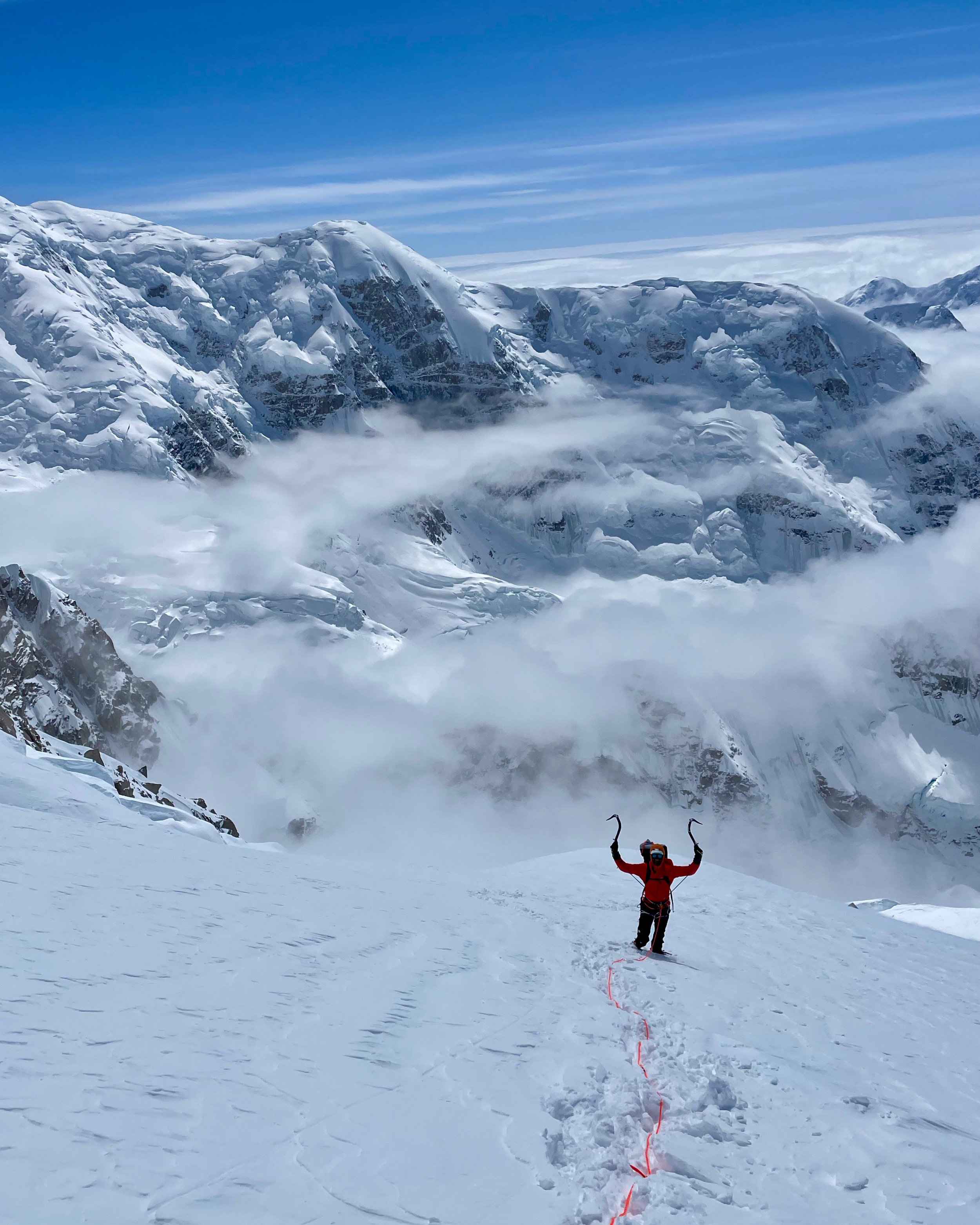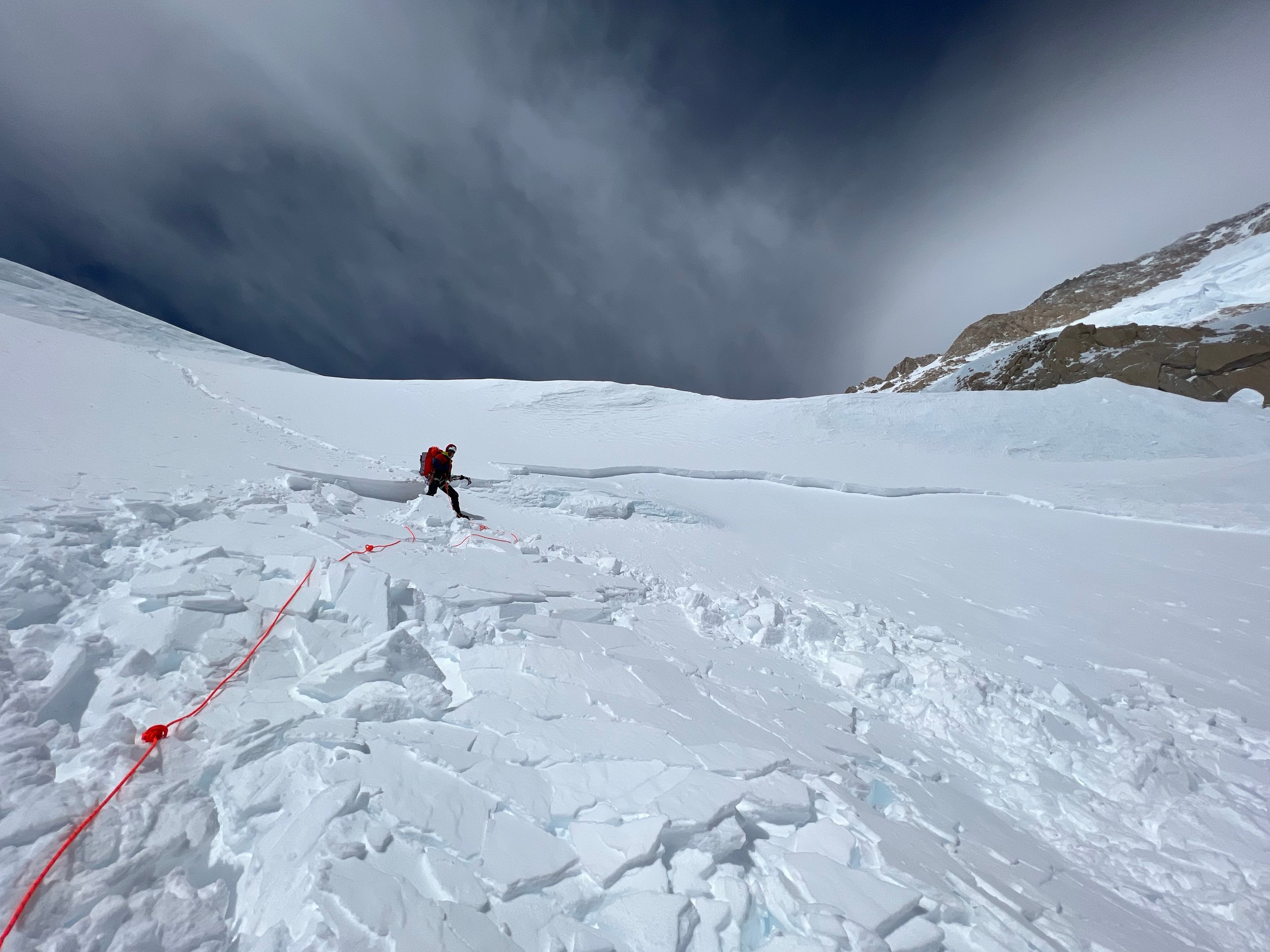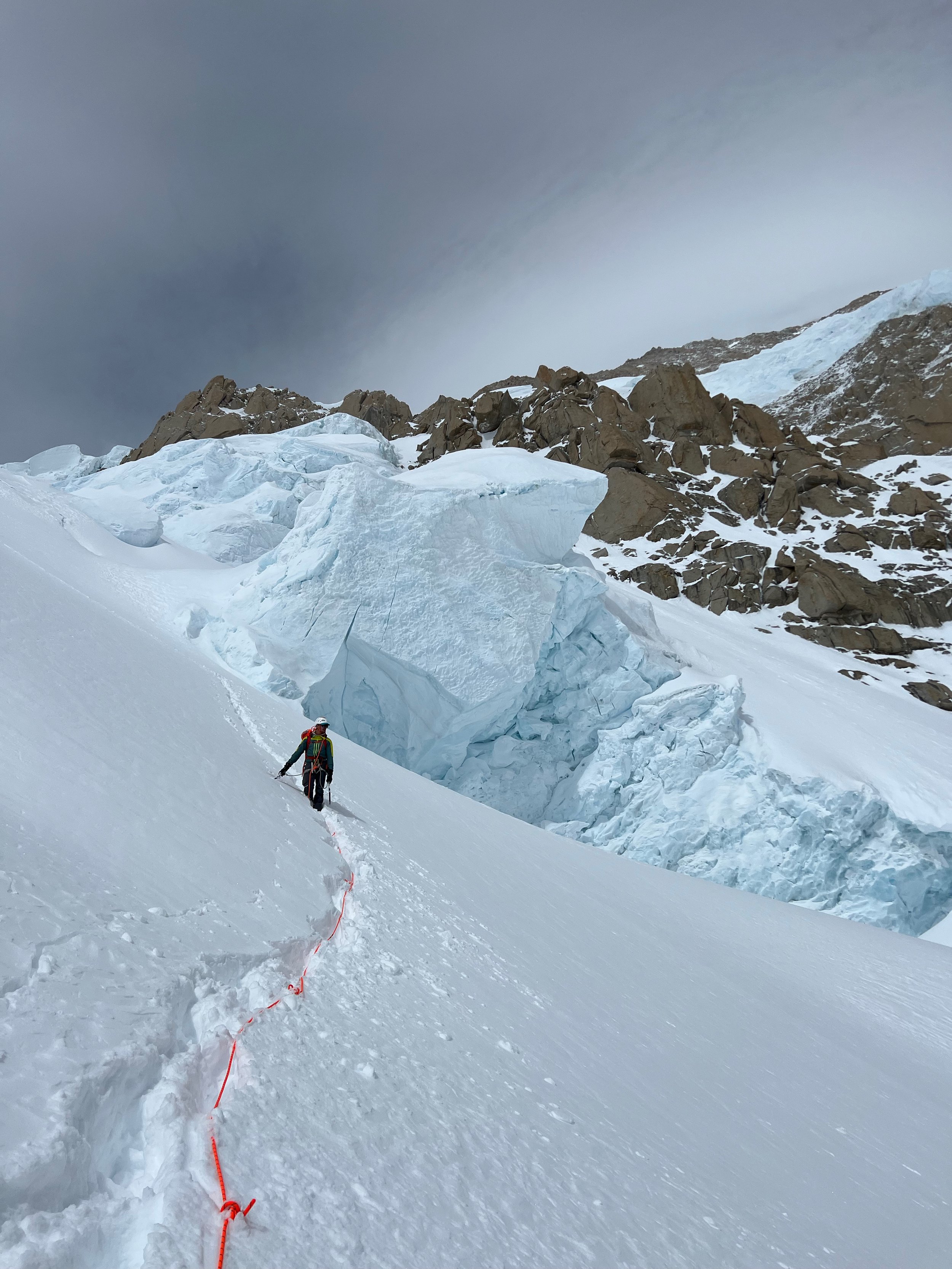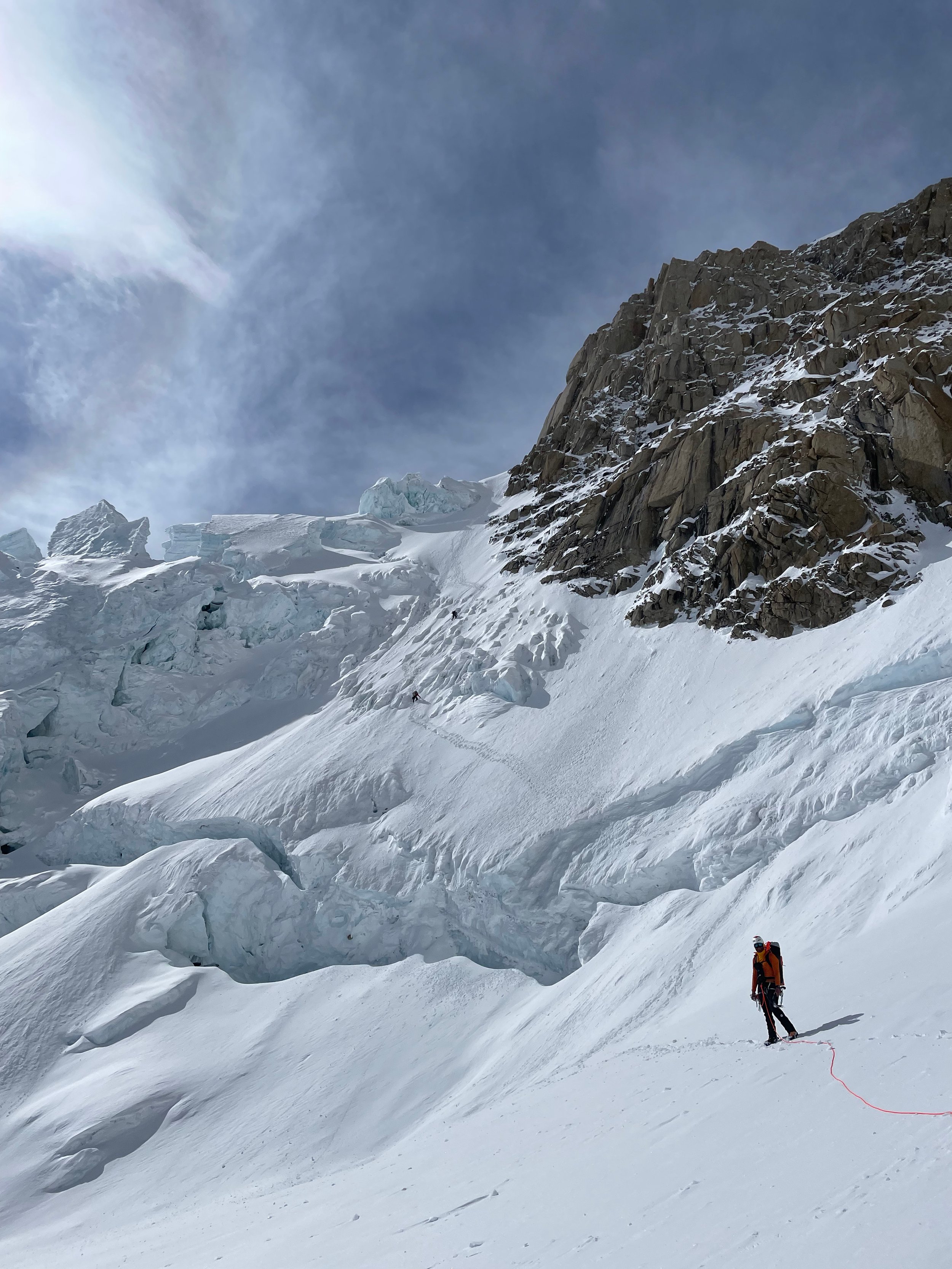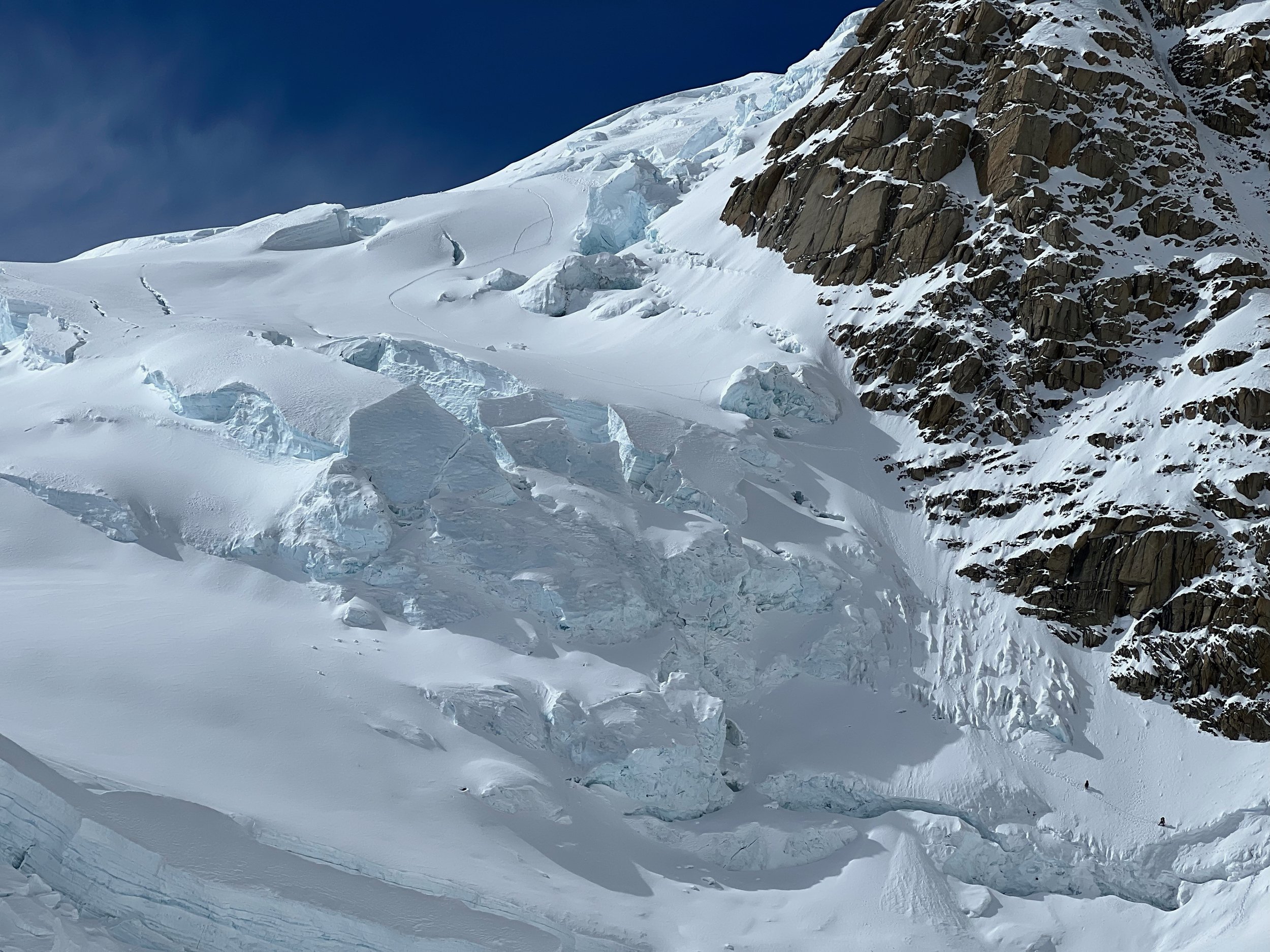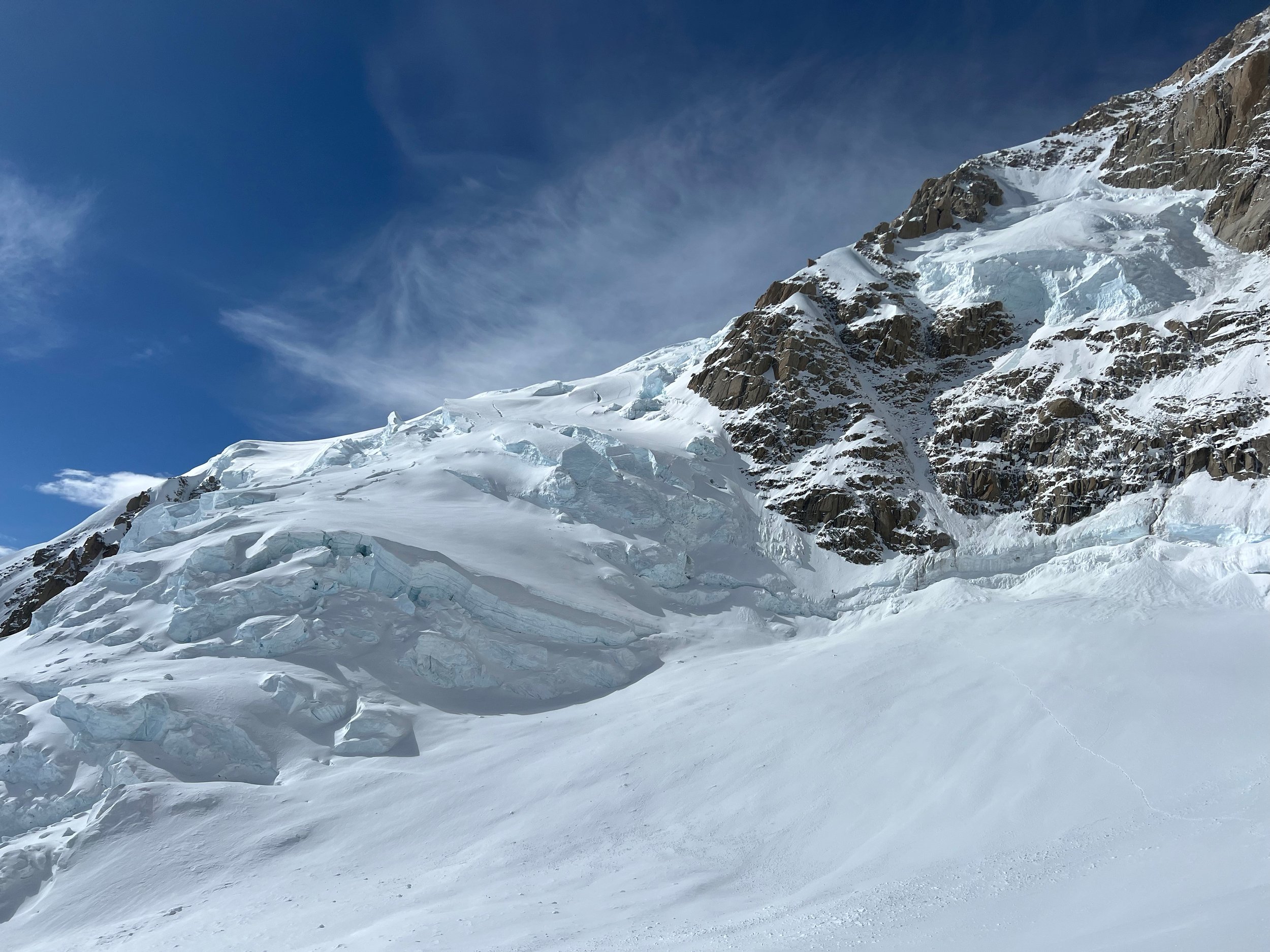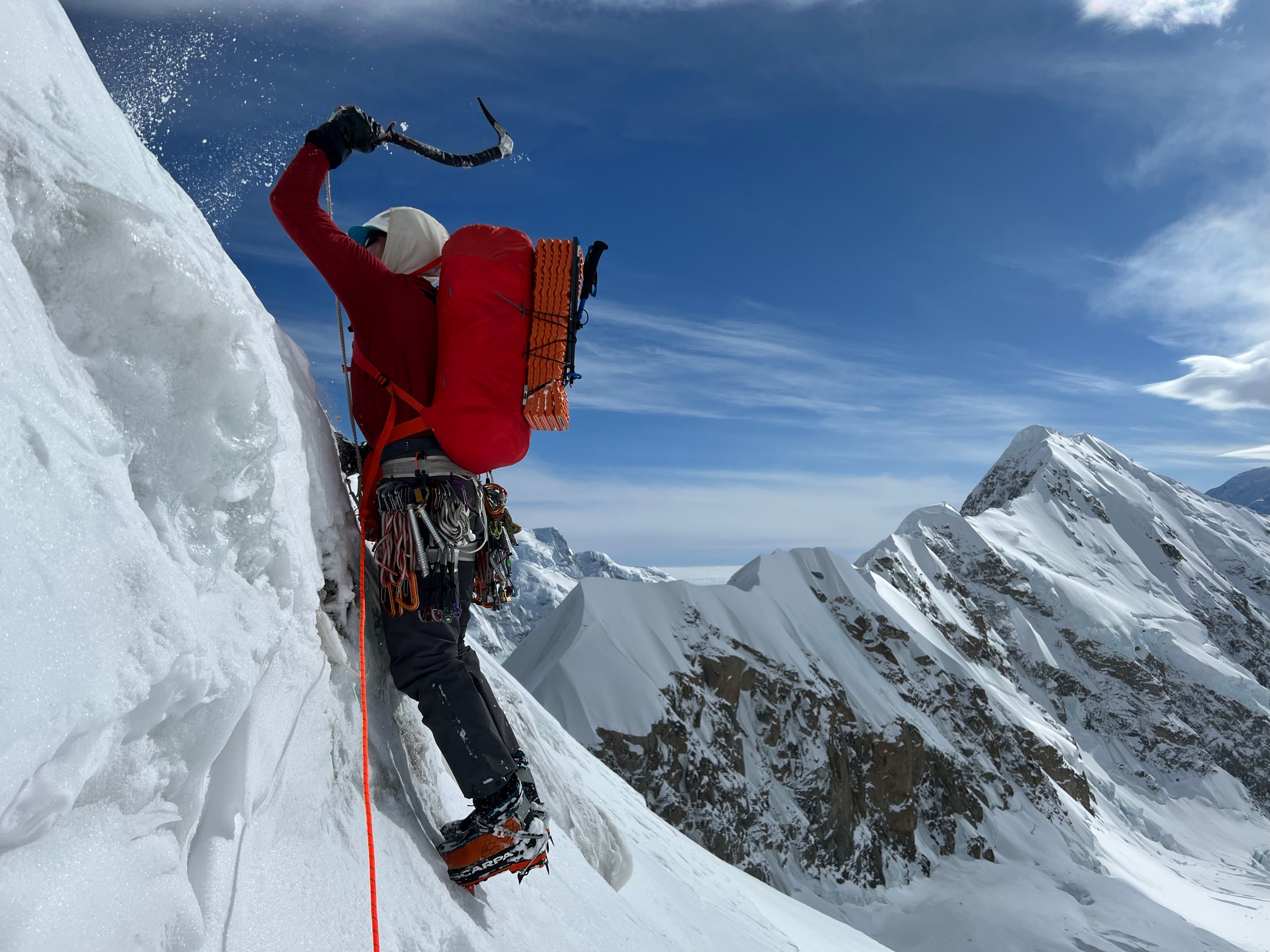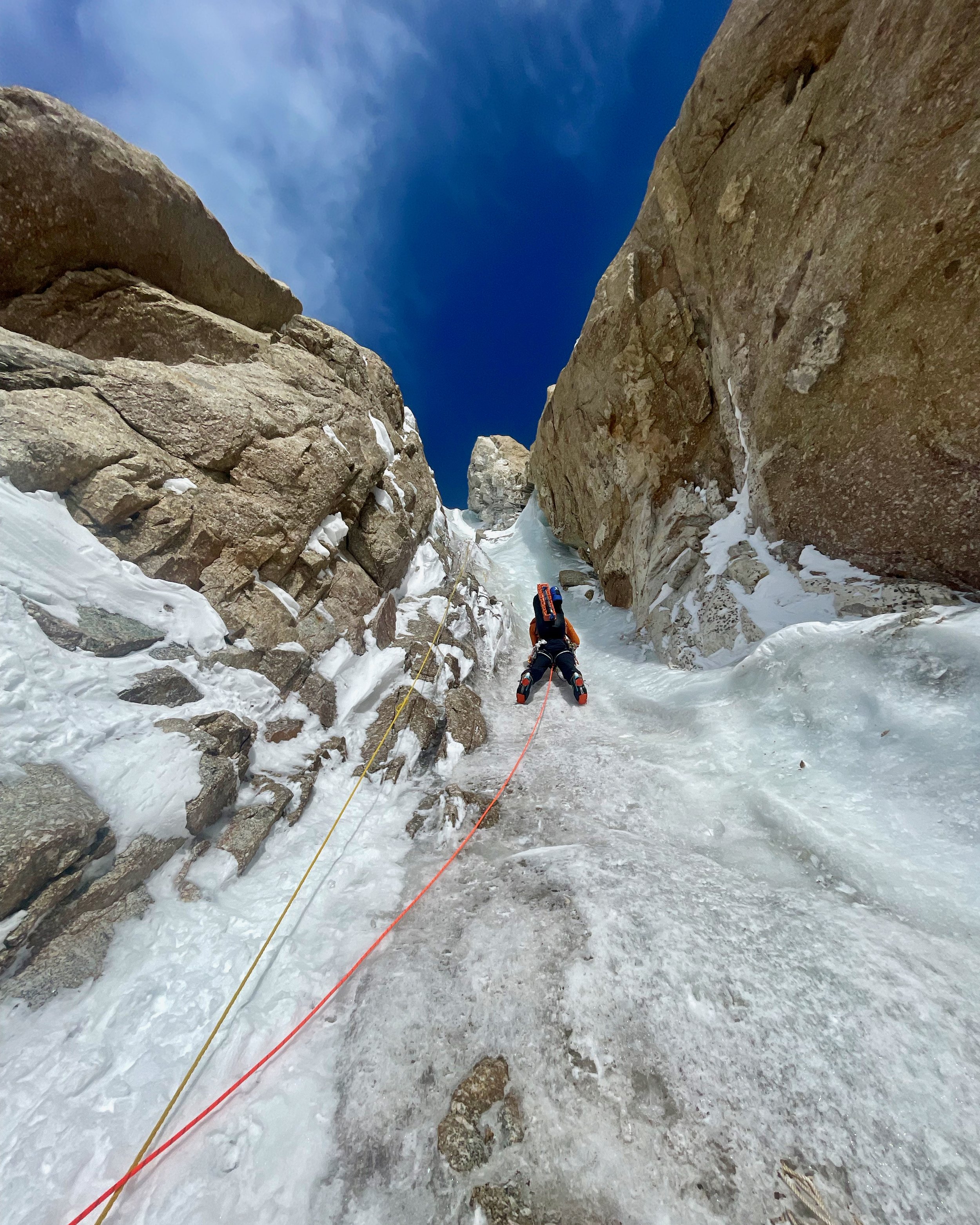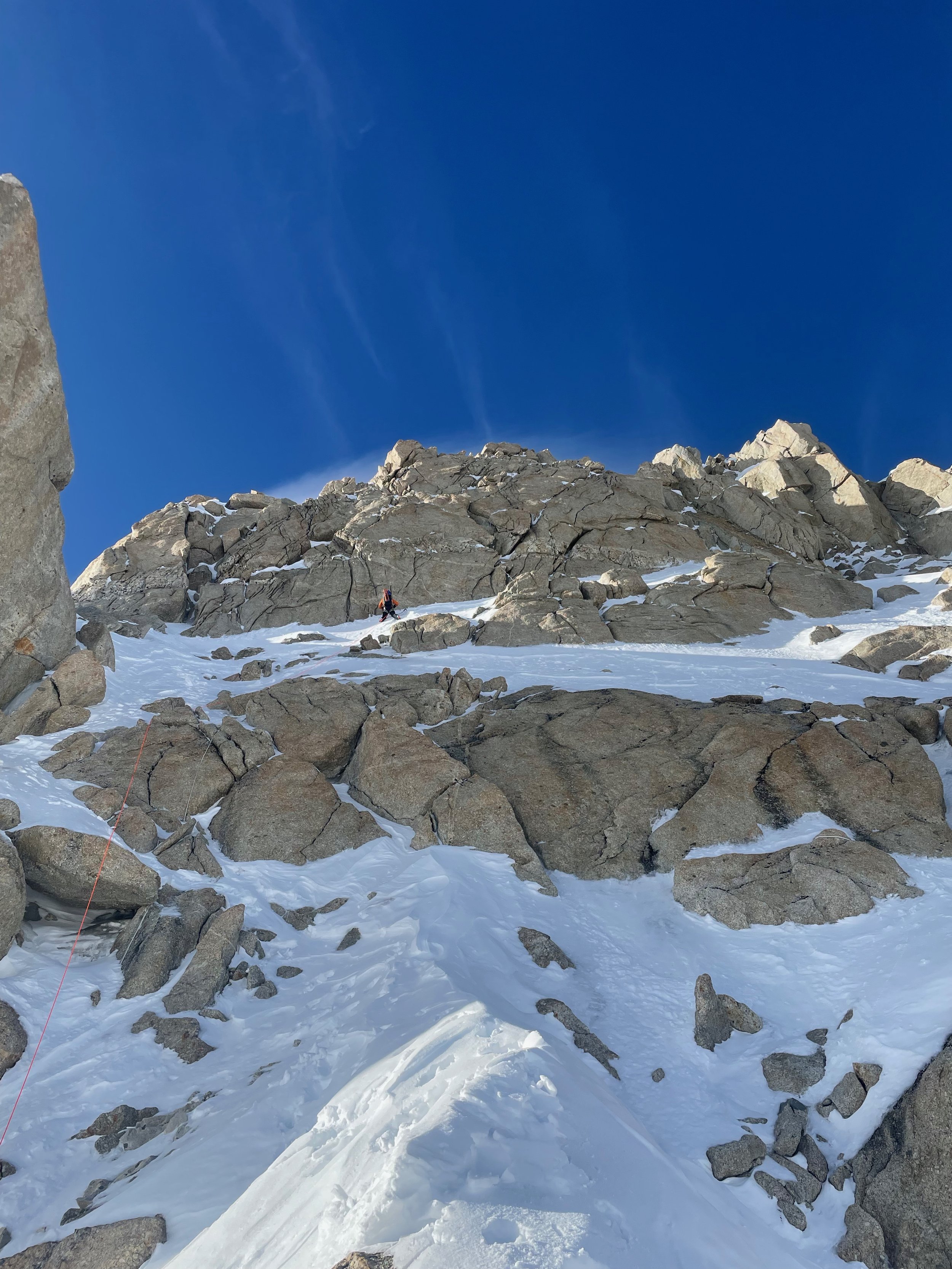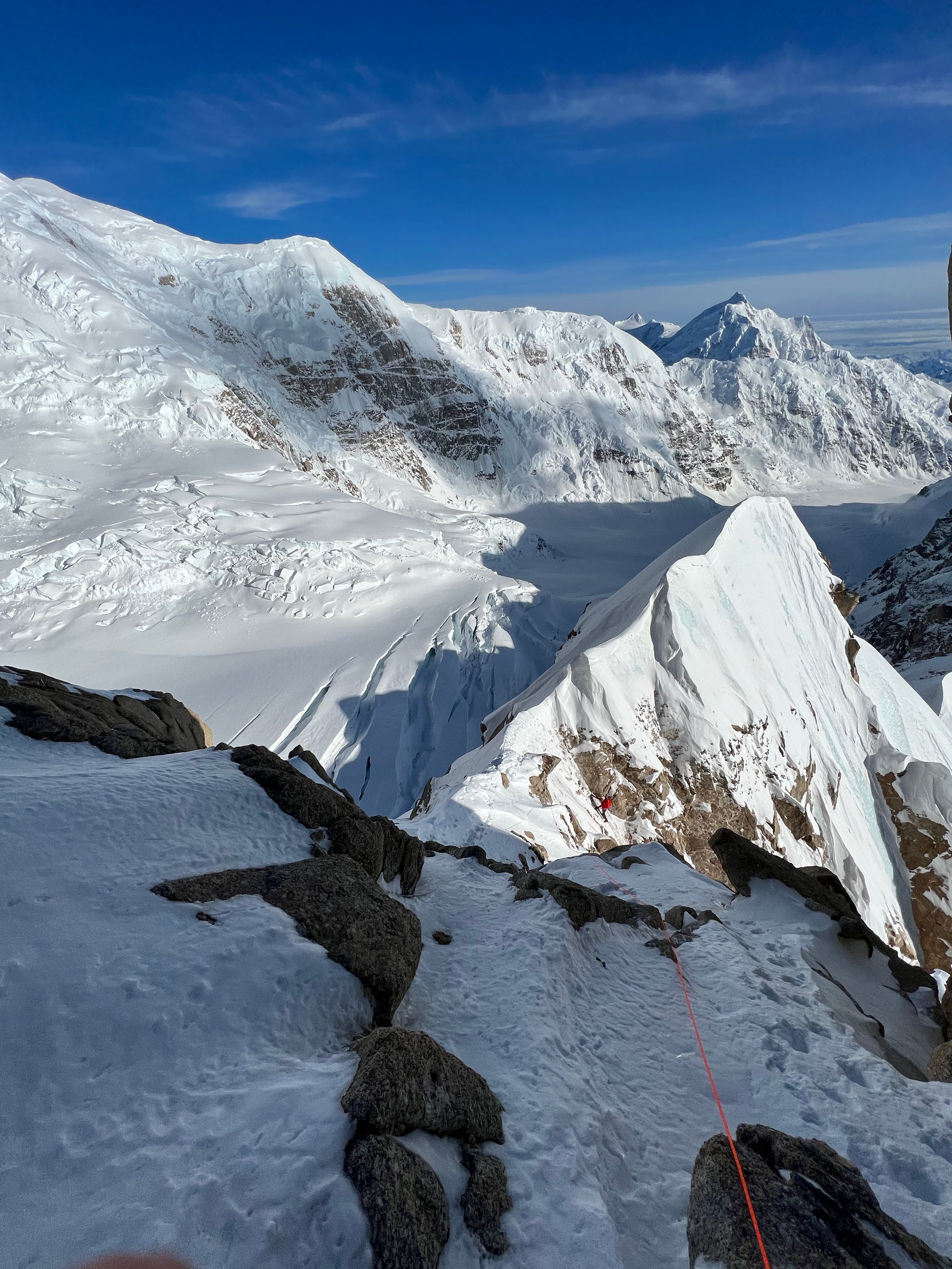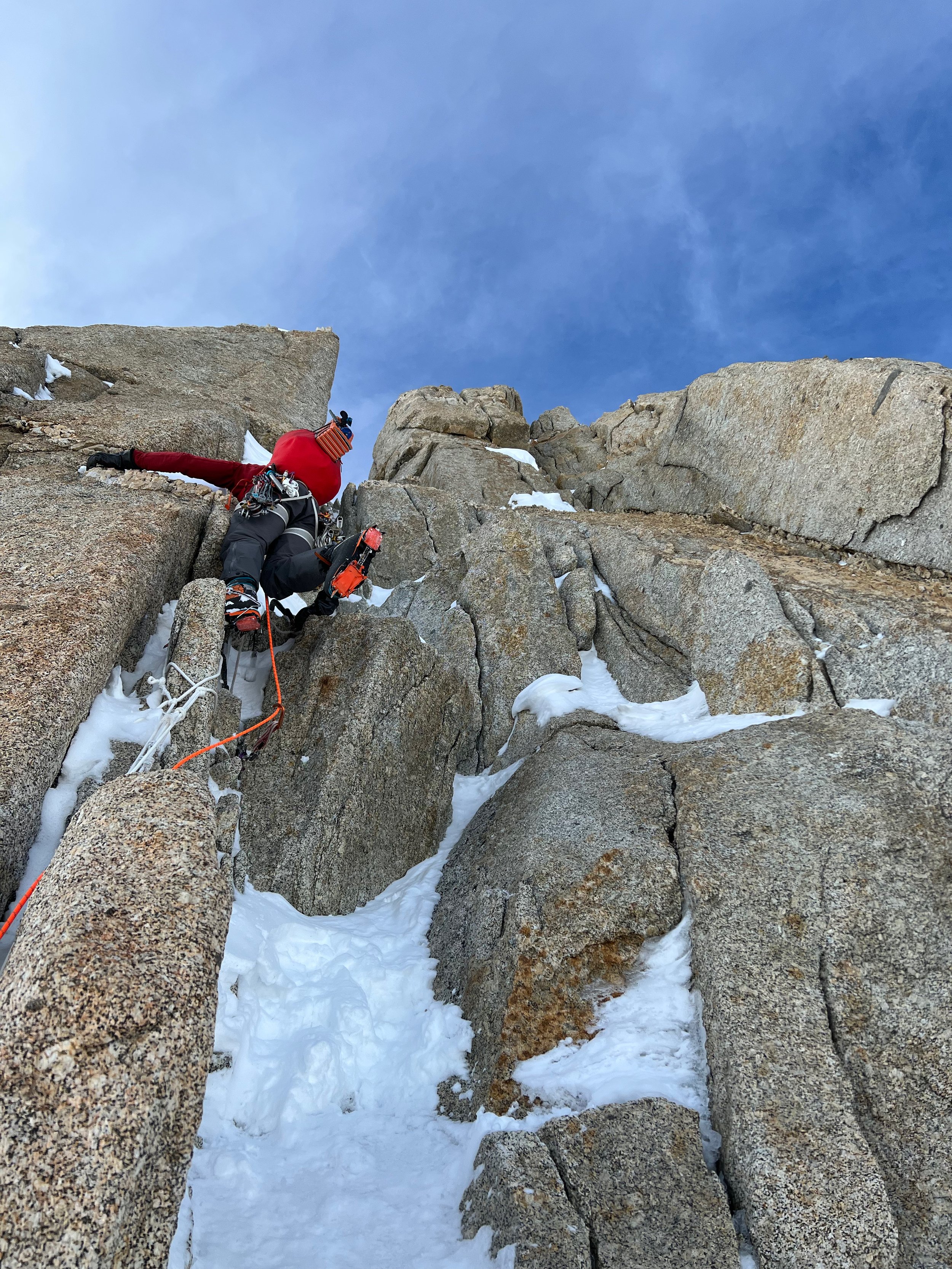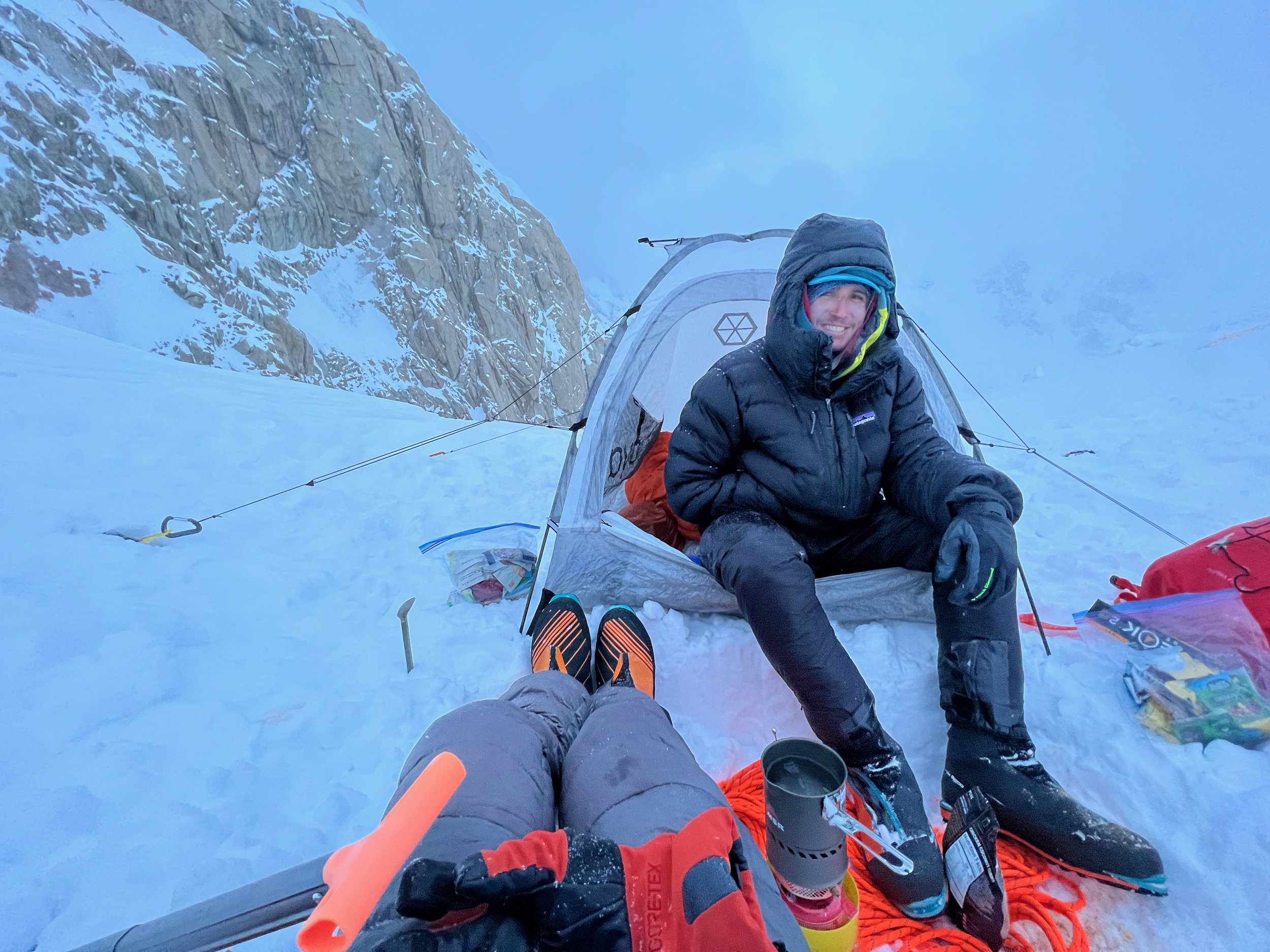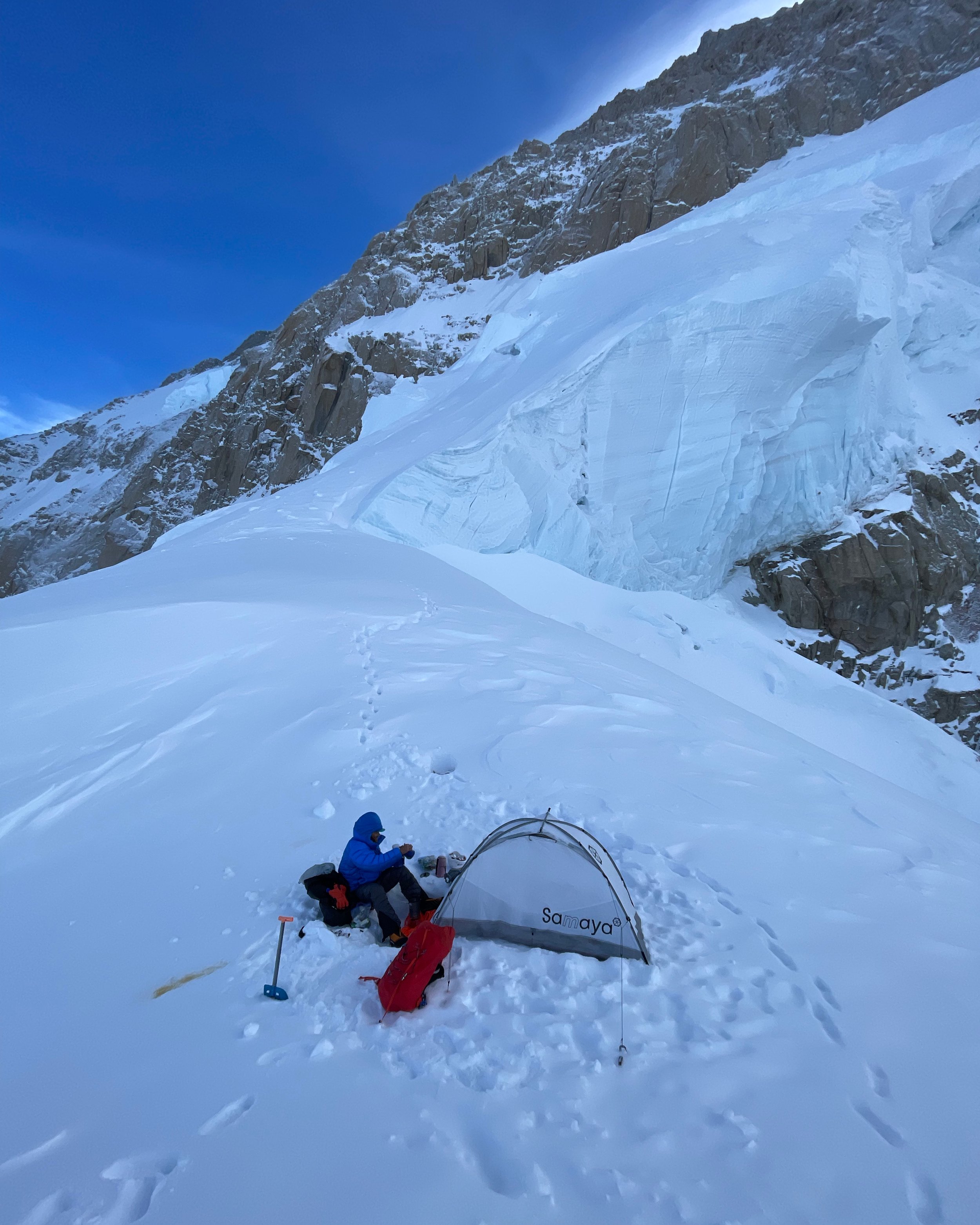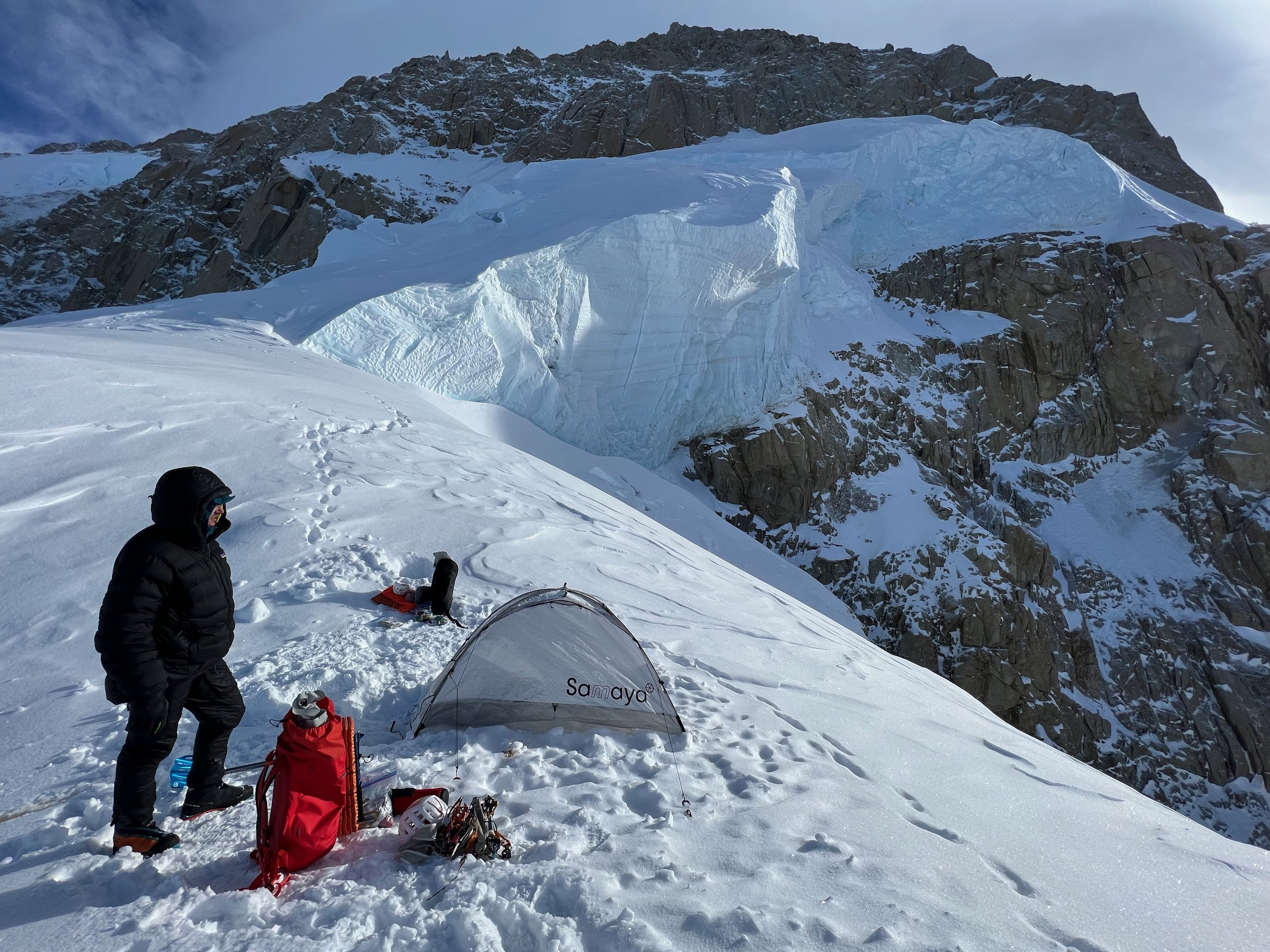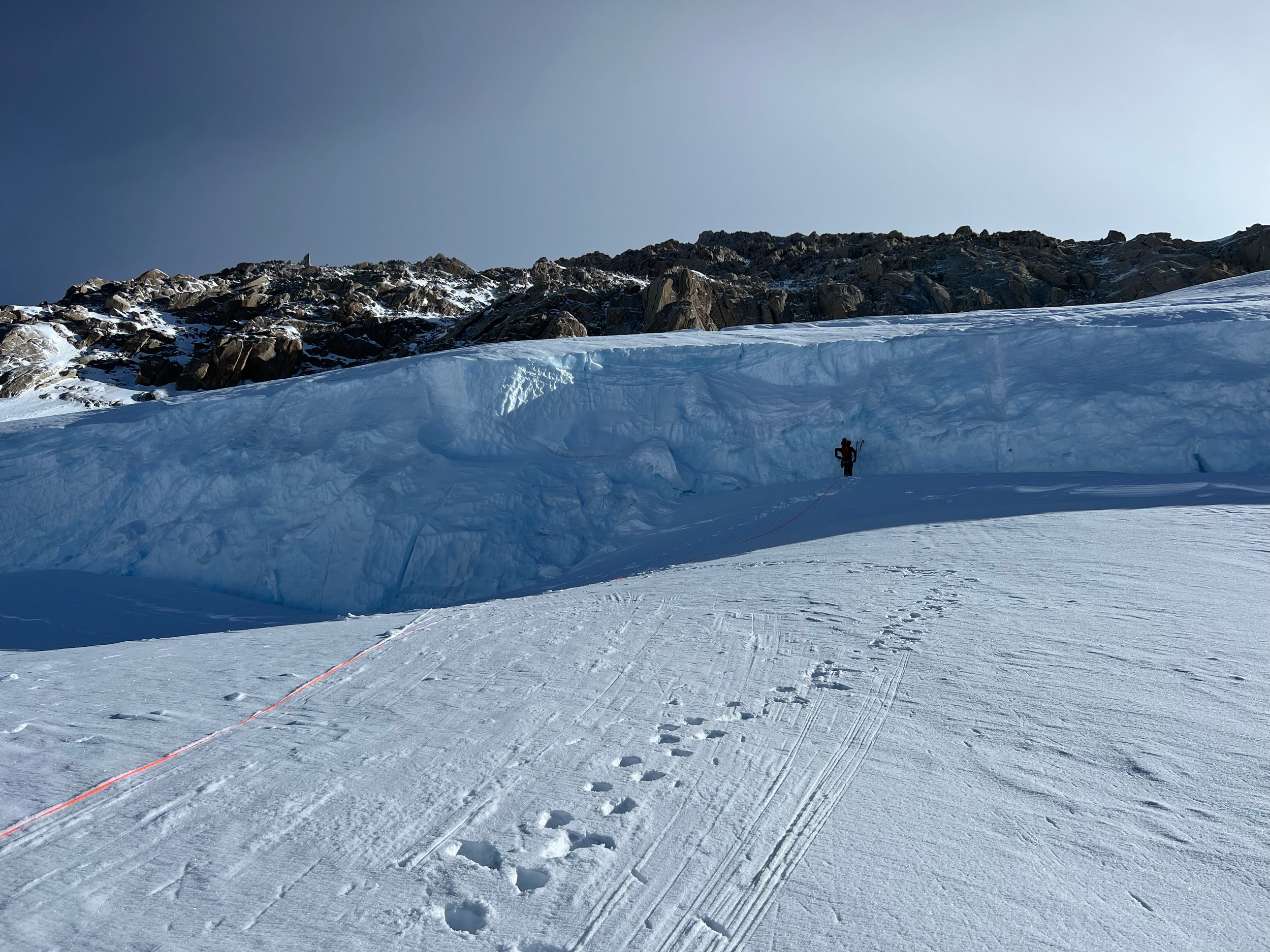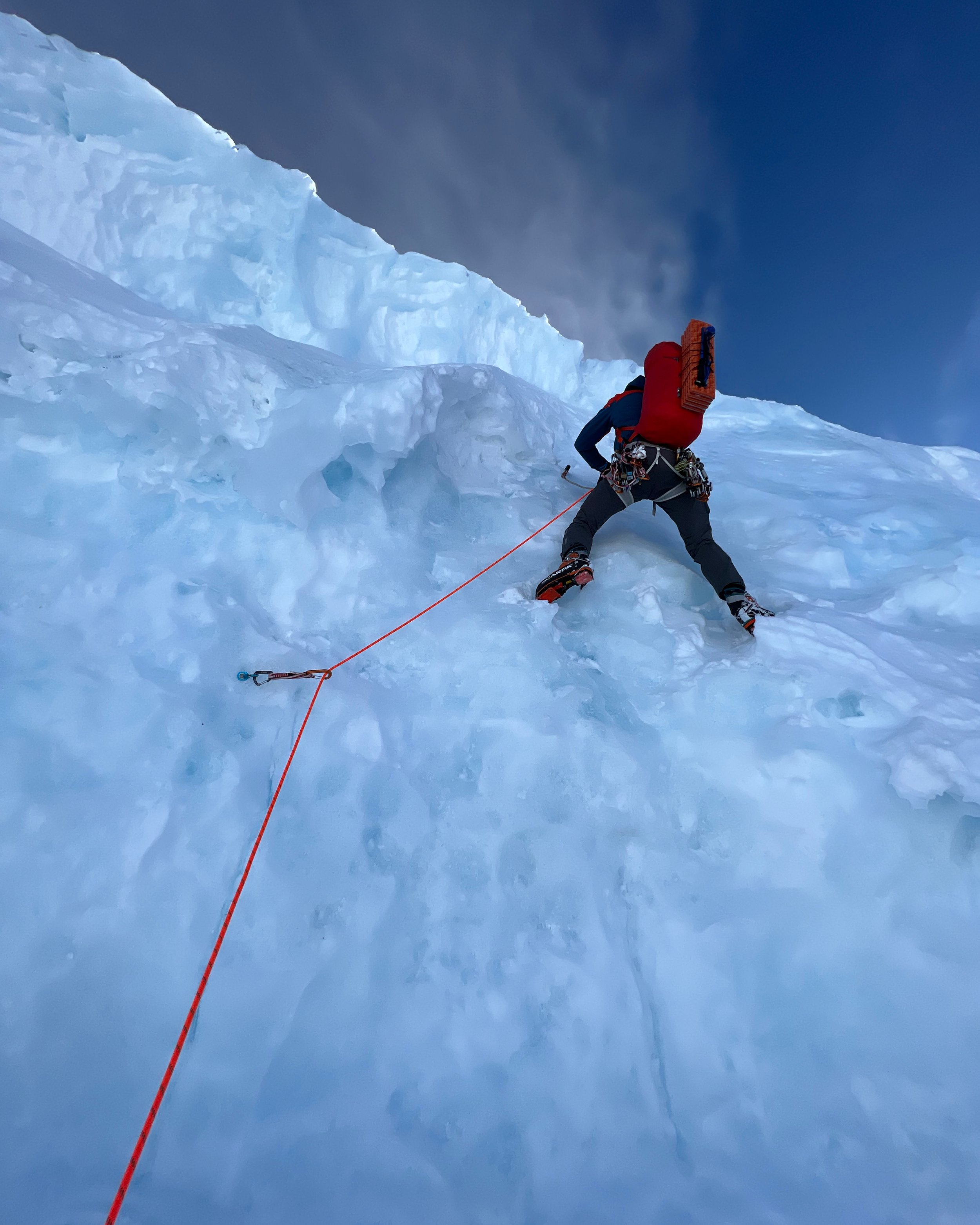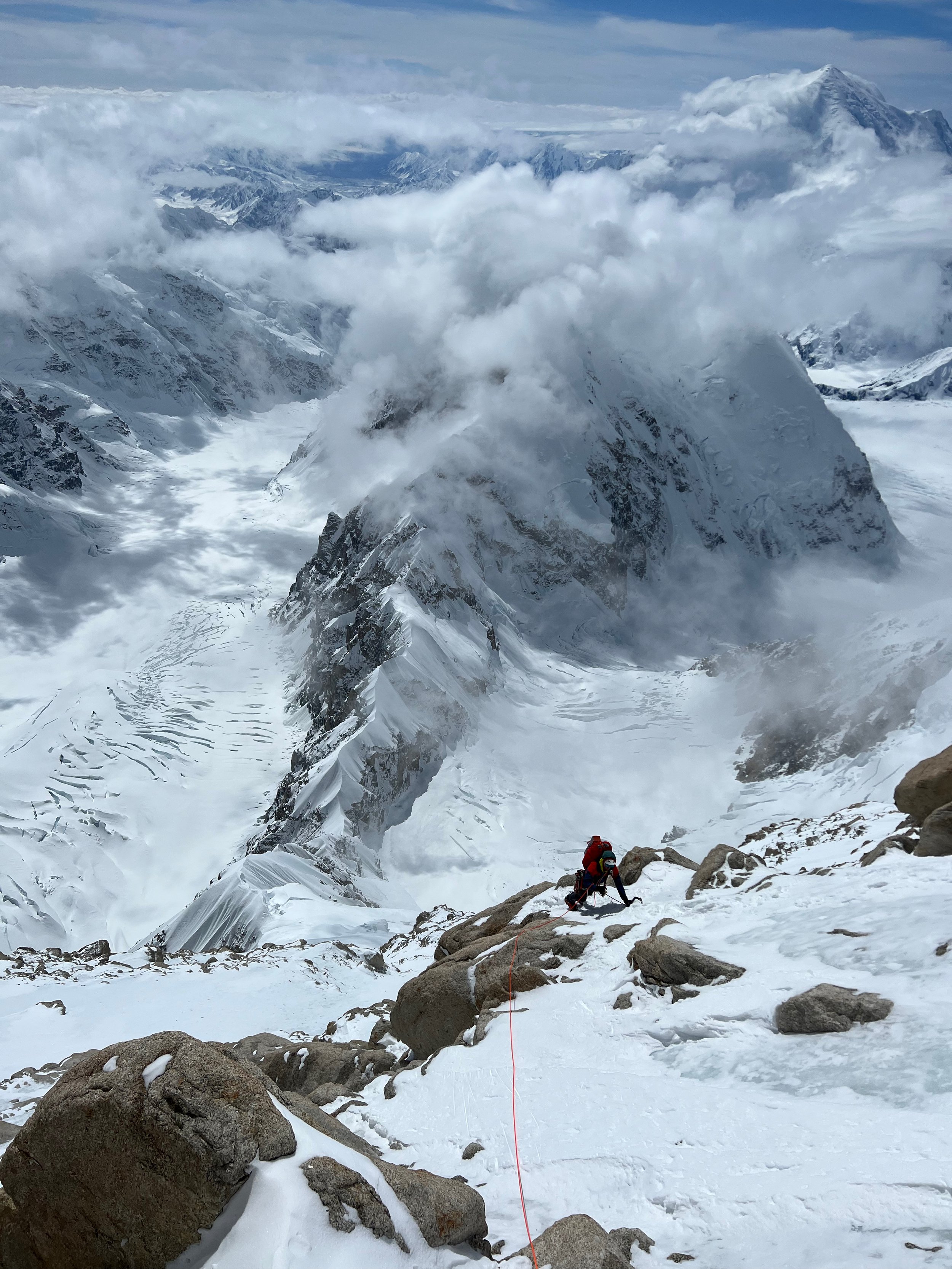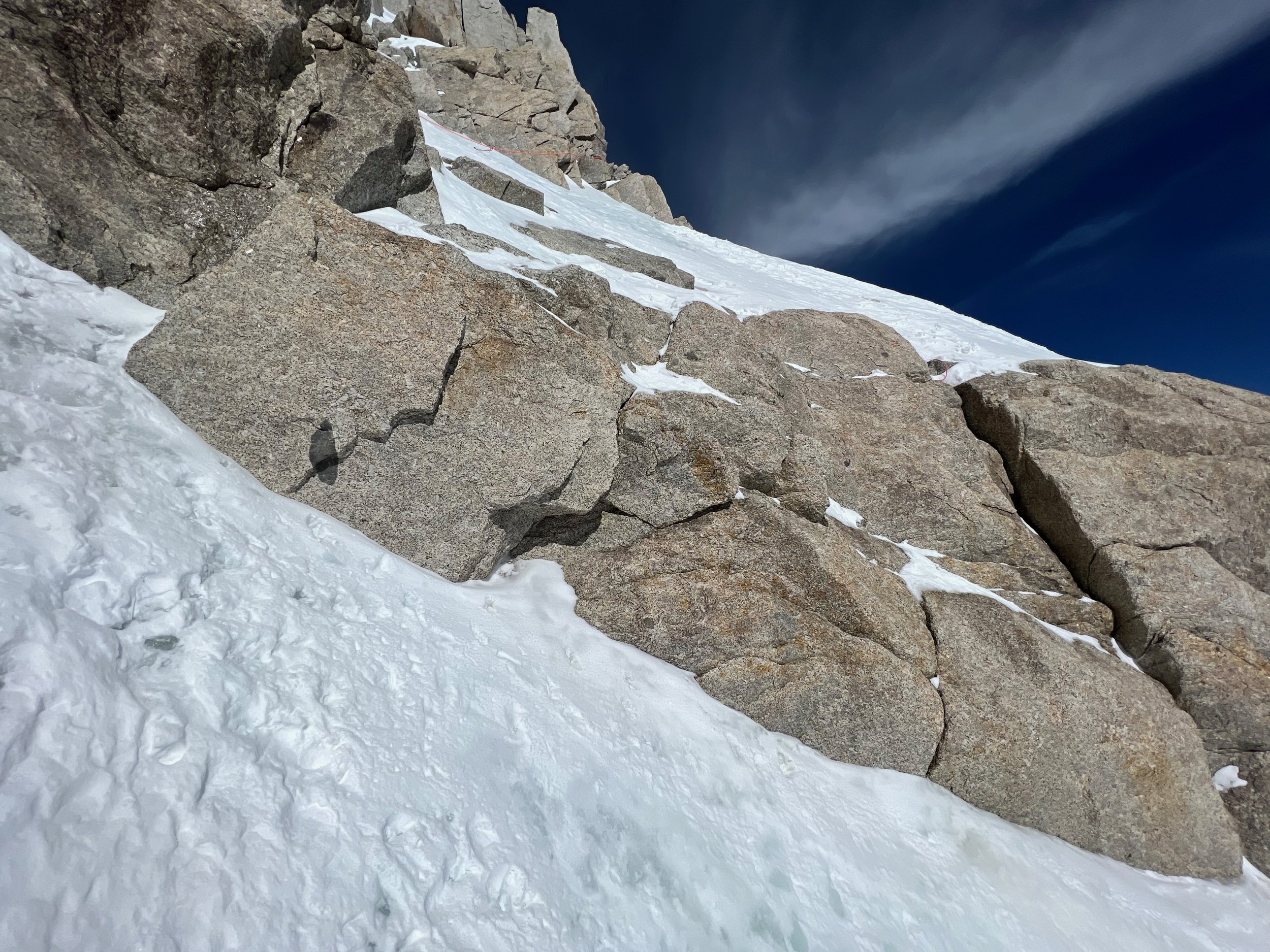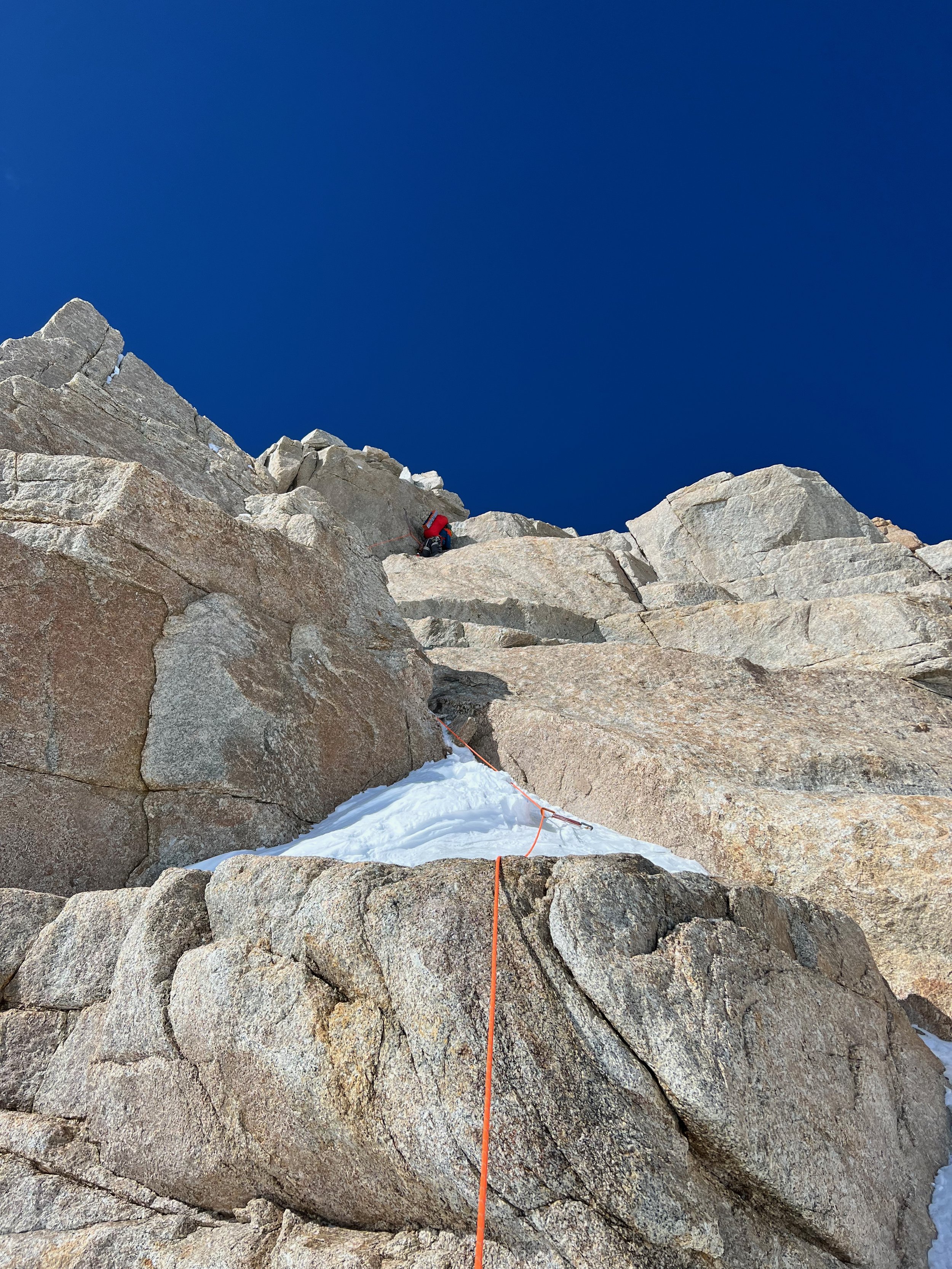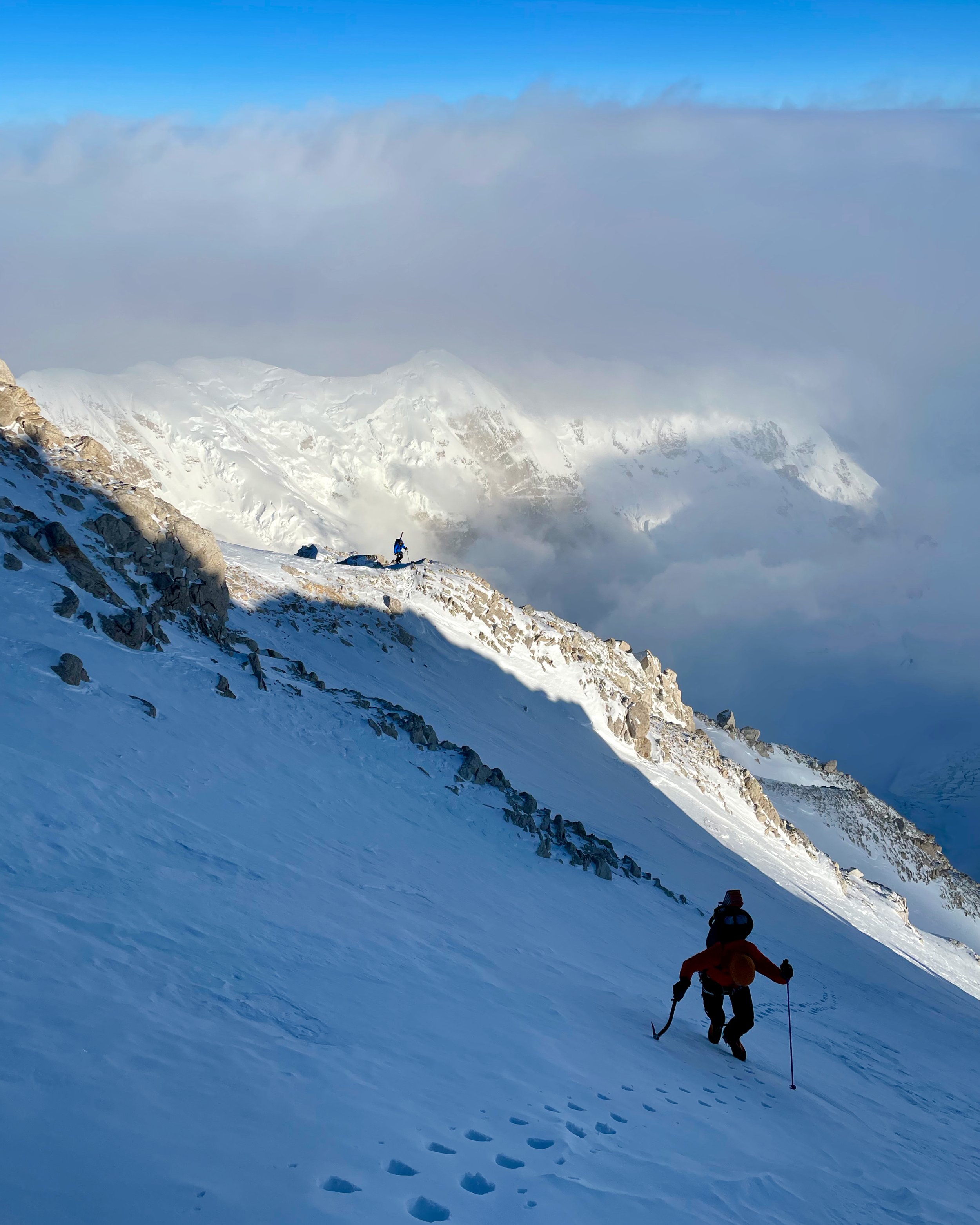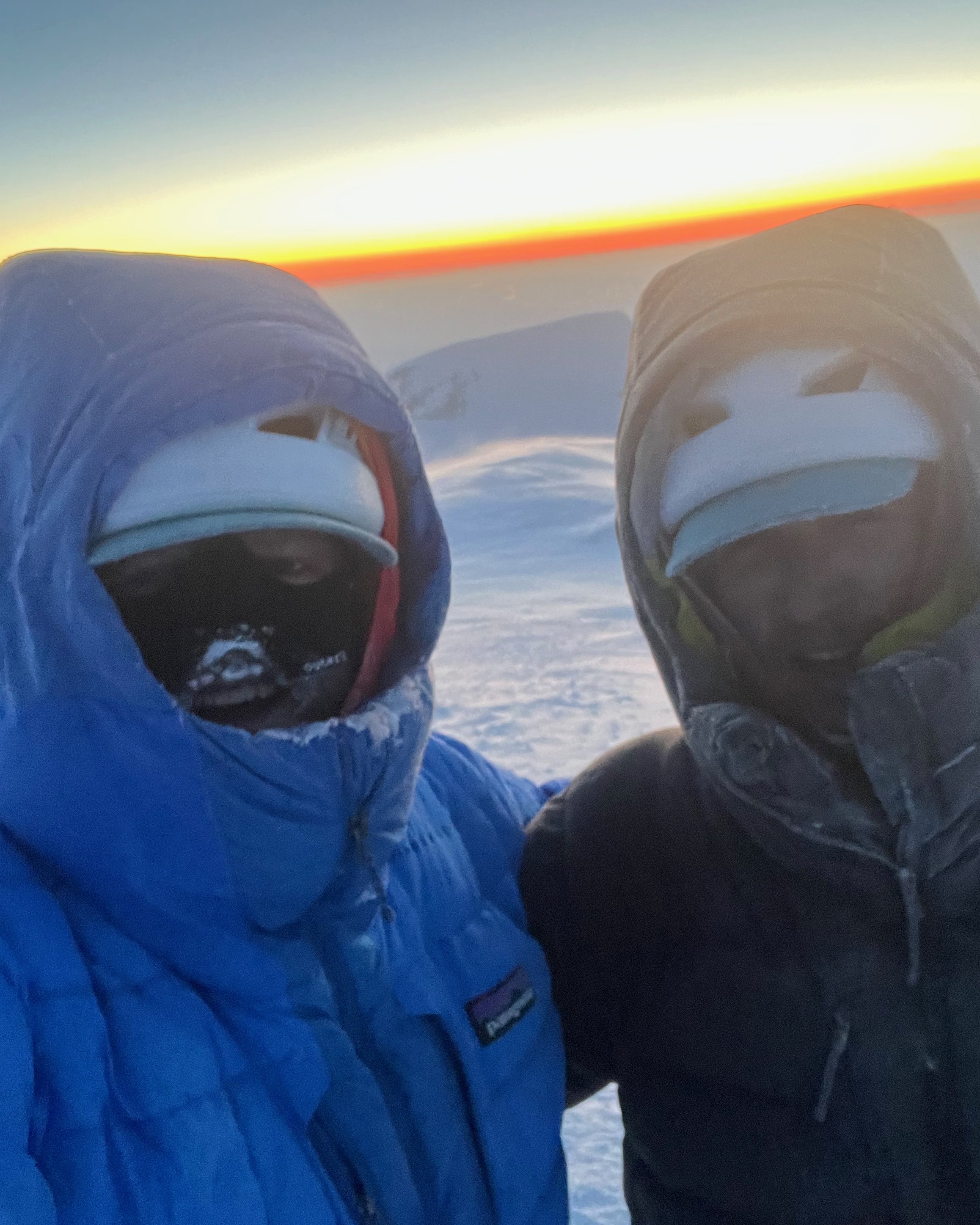Denali 2023: Cassin Ridge and Messner Couloir
Dates: May 13 - June 9, 2023
Trip Report:
Ever since I started ice climbing, the Cassin has been a huge goal of mine. I don’t remember where or when I first heard about it; it may have even been before I swung a tool for the first time. The combination of technical climbing coupled with a massive aerobic effort finishing atop of North America’s highest peak has always appealed to me.
The Cassin prep for Chris and I officially started over a year prior when we made our first trip to the Alaska Range and climbed a bunch of classics in and around the Ruth Gorge. We lucked out with 2 weeks of high pressure and were able to climb a bunch of great routes: the SW Ridge of 11,300, Ham and Eggs, and Shaken not Stirred. This trip gave us exposure to most of the components needed to find success on the Cassin; many pitches of 5.8, lots of alpine ice, bivying on route, and complex crevasse navigation. The only missing parts were the high-altitude component and sled hauling. As a whole, our Ruth trip went great, and we learned a lot that would serve us well on Denali. It’s possible to successfully climb the Cassin on one’s first trip to the Alaska Range, but it sure is nice to work out the kinks prior.
Hauling Sleds to 14 Camp
We flew in late in the day on May 13th after waiting for clouds to clear above KIA. We flew in with a ridiculous amount of food as we were planning on spending 10-14 days on the Kahiltna to hopefully climb the North Buttress of Mount Hunter. The first 3 days were spent hanging out in the dome cook tent waiting out a storm accompanied by Aidan, Will, Graham, and Carter. One evening, we got a reprise from the snow and were able to sneak in some fantastic skiing off Annie’s Ridge. We had heard multiple accounts that the North Buttress wasn’t in great shape so when the weather cleared on May 17th, we decided to head up to 14 Camp. We had no idea how many days of sled dragging were ahead of us after hearing horror stories of it taking some parties almost a week, so we were mentally prepared for the worst. We were able to make it to Camp 2 at 9,400 ft on our first day. We had the majority of the weight in our sleds which worked great on flat terrain but was pretty heinous going up Ski Hill. We quickly learned that anytime there was any sort of incline, you’re far better off with most of the weight in your pack. We set up camp at 9,400 ft and devised a plan for the coming days. We had 2 weeks worth of food and fuel with us and we decided to cache a weeks worth at 9,400. This would give us the option to drop down to get the food at a later date without sleds or not get it at all if there was an abundance of food being given away at 14. We left camp set up at 9,400 and spent the next day hauling food and Cassin gear to cache at 14. The following day, we packed up camp and hauled our remaining gear up to 14 Camp. This strategy allowed us to get everything from the airstrip to 14 Camp in less than 3 days and it never felt too miserable. I think our strategy to have bigger days with lighter loads was the move. We were all settled in at 14 Camp late in the day on May 19th.
14 Camp and Summit #1
We took a rest day on May 20th and then went to the top of the fixed lines with Aidan and Will on May 21st. We had plans to go up to 17,000 ft via the Rescue Gully but stormy weather rolled in as we were crossing the bergschrund at the base of the Rescue Gully, so we traversed hard left to hit the fixed lines. We climbed the fixed lines and chilled above them for a few minutes before heading down. We didn’t have big summit plans for May 22nd, but we slept in and awoke to clear skies, so we decided to go for the top. We rolled out of camp at a leisurely 12:30 pm and were standing on the summit 8 hours later. The terrain was all very casual, but I couldn’t believe how hard movement felt above 19,000 ft. I was pretty cold when we hit the summit and didn’t feel like transitioning, so we walked down to the edge of the Football Field at Archdeacons Tower and put on skis there. We skied all the way back to 17 Camp and surprisingly, the Autobahn was pretty chill. We made it back to camp around Midnight, satisfied with our first Denali summit, knowing each subsequent attempt would hopefully feel better. We took a rest day the following day and then dropped to 9,400 ft to get our cache on May 24th. Round trip, it only took us 5.5 hrs and the ski down was delightful.
Skiing the Messner
The weather looked good on May 27th, so we set our sights on skiing the Messner Couloir. We summited via the West Butt and clicked into our skis right at the summit marker which was pretty cool. Other than a period of not feeling great on the Autobahn due to dehydration, life above 19,000 ft felt a little better this time. Thankfully, I had a GPX track for the Messner because the entrance wasn’t super straight forward. After traversing hard left and then hard right, we were finally at the top of Messner and ready to ski the fall line. Conditions were a big unknown as we were the first party to ski the Messner for the season, so we skied the top part very cautiously. The top 500 ft weren’t too steep but the predominant snow condition was featured sastrugi. It wasn’t good skiing, but at least it wasn’t scary skiing. Once we made it past the wind affected snow, the conditions improved dramatically. We enjoyed close to 4,000 ft of awesome, boot top powder and couldn’t believe how good conditions were. Up until this point, the skiing was never too steep and felt relatively mundane. Unfortunately once we got lower, we were skiing 4 inches of sticky powder over blue ice which was surprisingly decent (for a while). We skied as cautiously as we could; Chris took the reins and skied each pitch first. We did a lot of traversing to try to find the sections with the best coverage. Chris eventually hit a thin section and had a close call when he started sliding on blue ice. Thankfully, he was able to self-arrest and we made the very obvious decision to go in direct to a screw so we could switch to crampons and down climb until conditions improved. We didn’t have a great plan on how we were going to navigate the schrund at the bottom and figured we’d wing it since we had a rope with us. In retrospect this probably wasn’t the best strategy, but it worked out in the end. After downclimbing a few hundred feet of snow covered AI2, we found a weakness through the schrund and were able to cut hard skiers left to get in the West Rib Cut Off Gully. We also punched through some shallow snow bridges crossing over so it’s definitely a heads-up zone. From here, we transitioned back to skis and made our way back to camp. To our surprise, all of 14 Camp had been watching us and witnessed our close call. The funny thing is that we had talked about climbing the Messner to the 17 Camp connector the day before, and if we had, we probably wouldn’t have skied it. If I were to ski the Messner again, I would wand the schrund at the base on a prior day as it’s very hard to navigate top down if you actually want to keep skis on the whole way. Oh yeah, and I probably would have started down climbing a little earlier.
The Cassin!
After 2 trips to the summit, we were well acclimated and all there was left to do was to wait for a weather window for the Cassin. There would be a day or an afternoon of good weather, but no weather window long enough that we would be comfortable climbing the Cassin. We passed the time by sleeping, eating, and occasionally skiing below the fixed lines. After a lot of back and forth, we decided to launch for the Cassin on the morning on June 4th. The weather looked good for 48 hours and didn’t look horrendous after that, so we made the executive decision to go for it. The Seattle Boys (Jared and Aaron) left camp a few hours before us, and we were able to follow their bootpack up to the West Rib Cut Off which saved a lot of energy. We eventually caught up to them on the Seattle Ramp about 1,500 ft into our descent. I’m sure we didn’t take the best path down the Seattle Ramp but navigating the crevasses weren’t trivial. There was one particularly challenging section that probably took us an hour to cover 300 ft. Massive cracks were covered with thin snow bridges and rotten ice that couldn’t be trusted. The Anchorage Boys (Dalton and Calvin) even fell 30-35 ft into one of the crevasses later that same day. Lower down, we triggered a sizable avalanche in one snowy section but thankfully both of us were able to self-arrest and avoid going for a ride. The bottom section of the Seattle Ramp was also tricky with some frozen vertical gravel downclimbing and some tricky shrund downclimbing. Miraciously, we were able to avoid making any rappels. The Seattle Ramp seems to be known as the “safe option” compared to going up the NE Fork, but it certainly possesses its own set of risks. We briskly walked over to the base of the Japanese Couloir and took an extended snack break. We started up the Japanese Couloir at 6 pm with the goal of atleast making it to the Hanging Glacier Bivy at 14,000 ft. Our plan was to simul as much of the route as possible. Chris took the first block and brought us to the base of the AI4 pitch. I took the next block and was able to climb all the way to the Cassin Ledge 5.8 pitch. The AI4 pitch was in great shape and fair for the grade. We pitched out the Cassin Ledge with Chris taking the lead. Other than a little chimney awkwardness, it felt pretty easy for the grade. I took the next block and was able to take us up the Cowboy Arete to the Hanging Glacier. I found a every condition imaginable on the Cowboy Arete, from blue ice to bottomless facets. This section was very slow going but never overly hard and eventually we found ourselves at the Hanging Glacier. We had discussed trying to get to the top of the First Rock Band on the first day but it was almost midnight so we decided to bivy at the Hanging Glacier. To our surprise, we heard foot steps outside the tent once we were in our sleeping bags and found out it was Nathan who was soloing the route with skis. After a cozy night in the Spoonbill, we woke up and were stoked to have Nathan’s tracks to follow. The Hanging Glacier pitch was short, but was definitely the crux of the route for us. It was very short, but felt significantly harder than any pitch of WI5+ I’ve climbed. Chris insisted on leading it with a pack and cruised up it without issue. We switched back to simul climbing mode and made it from the base of the First Rock Band to the base of the Second Rock Band in 2 huge blocks. We put in another block and then pitched out the final two 5.6 pitches. Both felt harder than the 5.8 Cassin Ledge pitch, but we might have messed up the micro route finding.
Overall, I was blown away with how much ice was on route. Other than the Cowboy Arete, we were either front pointing on ice or standing on rock. I was expecting much more snow in the First and Second Rock Bands, but I would take 5,000 ft of low angle ice over 5000 ft of waist deep wallowing any day of the week. We made it to the top of the Second Rock Band at 6:30 pm on June 5th and took a long break to brew up and eat dinner. We’re soft and didn’t want to bivy again, so we decided to push to the summit to get back to our comfy camp at 14. We both felt great leaving the brew stop and we’re very thankful for all the time we spent acclimatizing. To our surprise, we caught Nathan at 18,000 ft and took over the trail breaking duties. He nailed the navigation up until this point which was a huge help both mentally and physically. The snow conditions above the Second Rock Band were pretty ideal as it was mostly firm snow, and no real trail breaking was required. The navigation was straightforward as we just followed the ridge proper and worked around rocks as needed. Eventually, we lost the sun and it got pretty cold up there so we put our head down and kept grinding towards the summit. The last few hundred feet before Kahiltna Horn seemed to take forever, but aerobically, it was the best I’d felt above 19,000 ft. We hit Kahiltna Horn and dropped packs and almost ran to the summit, fueled entirely by adrenaline. For the third time, we stood on top of Denali at 2 am on June 6th. It took us 32 hours from shrund to summit which is a time I’m proud of for our first time on the route and carrying bivy gear and 3 days of food and fuel. It was pretty wild being up there in the middle of the night with the rising sun on the horizon illuminating Foraker and Hunter.
We headed down the West Buttress and the exhaustion really set in on the Autobahn. What we were able to descend in 5 minutes on skis, seemingly took forever and both of us were feeling it by the time we hit 17 Camp. We took a quick break with a 10 min nap mixed in and eventually stumbled back to 14 Camp after almost 24 hours on the move. We slept until the early afternoon and celebrated with a pancake and bacon “breakfast” at 2 pm. After 20 days at 14 Camp, we decided to pack up and head down on June 7th. The sleds were pretty annoying to get down to 11,000 ft, but it was pretty smooth sailing from there. We had talked about staying longer but my feet were pretty wrecked from frontpointing 5,000 ft of ice so we caught a flight back to Talkeetna on June 9th. The feeling of being back in civilization and being surrounded by vegetation after a month on the glacier is truly surreal. We spent most the day eating and attempting to dry out gear and partied at the Fairview with the Calvin and Dalton to celebrate the 100th anniversary of the Fairview and a very successful trip.
I want to touch on what I believe we did well, that contributed to our success on the Cassin. For one, we had time and we were willing to use it. So many people seem to not have enough time and end up with only 5-10 days where they’re at 14, acclimated, and ready to launch. To maximize the chance of success, I would give yourself at least 2-3 weeks at 14 Camp. Granted, not everyone has the liberty to take 5-6 weeks off work. We weren’t leaving 14 camp until we climbed the Cassin or we ran out of time so we were pretty committed to get it done. Having both the technical skills and being in sync with one’s partner, allowed us to simul almost the whole route which saved DAYS. Through the First and Second Rock band, there were countless 5th class steps with easier terrain mixed. Attempting to pitch out 5000 ft of this terrain would have added atleast a day or two on route and we probably wouldn’t have launched in the given weather window if this was our strategy going into it. We brought 2 Nanotraxes to protect the follower and I’d probably bring 3 next time. There seems to be a few good bivies on route and a lot of mediocre bivies. At least 2 parties in the past 2 years have dropped crucial items off the Cassin Ledge. The Cassin Ledge bivy is super exposed and less than ideal. The good bivies (ones you can actually unrope) seem to be the shrund at the base, the hanging glacier, and the top of the Second Rock Band. You always hear that a very small percentage of Cassin hopefuls start up the route and we witnessed it firsthand. I heard there were 17 parties registered with NPS to climb the Cassin and as far as I know, 4 parties (including Nathan’s solo) actually climbed it. There were a multitide of reasons people didn’t end up on route but the prevailing reasons were: lack of time, lack of stoke, frostbite, and altitude illnesses. Speaking of altitude illnesses, I would highly recommend taking Diamox. I know a lot of people (past me included) think of it as a PED... It doesn’t make you a superhuman at altitude, it just minimizes your chances of suffering from severe AMS, HAPE, or HACE. Countless people suffered from severe altitude illnesses while we were at 14 and from talking to the NPS rangers, almost none of the altitude cases they deal with involve people proactively taking Diamox. And it’s not the out of shape people suffering from altitude illnesses; It’s generally fit, un-guided individuals that get up to 14 fast. Obviously, I’m not a doctor and all this is just my opinion from my time at 14. I included my Cassin gear list below the photos.
Cassin Gear List:
Group Climbing
Rope (42m 8.0 mm)
6 ice screws (4x 13, 1x 16, 1x 19)
BD Z4 and Ultralight Cams (0.3-1)
WC Superlight Nuts
8 alpine draws
Petzl V threader
Beal Escaper
Individual Climbing
Blue Ice Choucas Pro harness w/ ice clippers
Petzl Nomics w/ Pur Ice Picks
Blue Ice leashes
Petzl Darts
Petzl Nanotrax on locker
ATC Alpine Guide w/ 2 lockers
2x lockers (Petzl Attache and Spirit)
Sterling Hollowblok
120 cm sling x2
Petzl Sirocco
Group Bivy
Ortovox Shovel
Samaya Tent
FF Spoonbill
MSR Reactor 1.0L
MSR Bowl to warm iso
Iso 8 oz (x4)
Lighters x3
Long Spoon
Individual Bivy
Foam pad (short)
Paper towels
Wet ones
Ear Plugs
Clothes
Patagonia Grade VII
Mammut Hybrid Wind Shell
Arc’teryx Proton LT
Rab R1
OR Echo hoodie
Stone Glacier Puffy Pants
NF hard shell pants
Craft tights
Medium wool socks
Lenz 6.0 heated socks (with battery and charger)
Buff
Hat
Face glove
Sunglasses
Gloves
OR Alti Mitt shells
Rab Pivot
Showas x2
BD Punisher
Liner Gloves
Electronics
Phone
Inreach
10k battery
iPhone cable
Garmin cable
Sock cable
